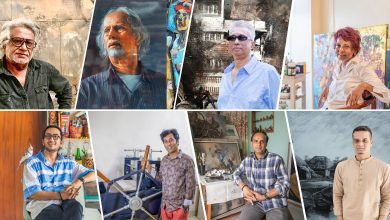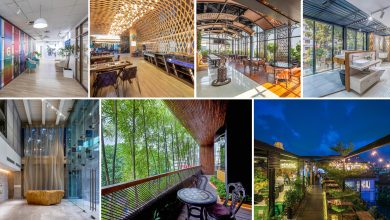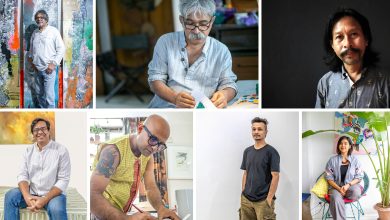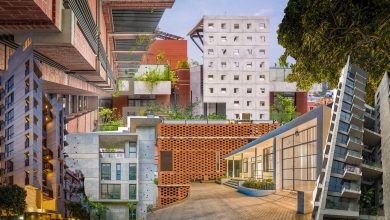- A Poetic Ode to Living
Nestled on the outskirts of bustling Dhaka, where the gentle embrace of the river Shitalakha meets the serenity of nature, lies an architectural masterpiece named CHAABI. Designed by the visionary mind Enamul Karim Nirjhar, this residence is more than just a home; it’s a symphony of spaces where every corner whispers tales of tranquility and connection.
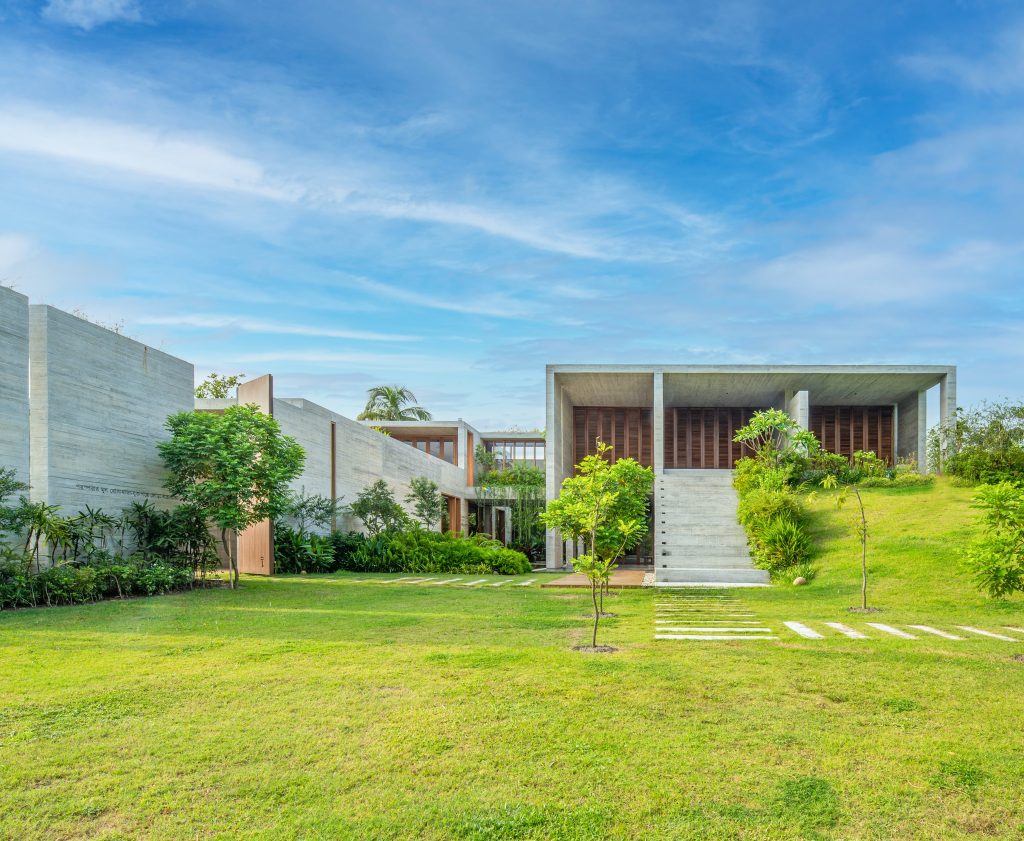
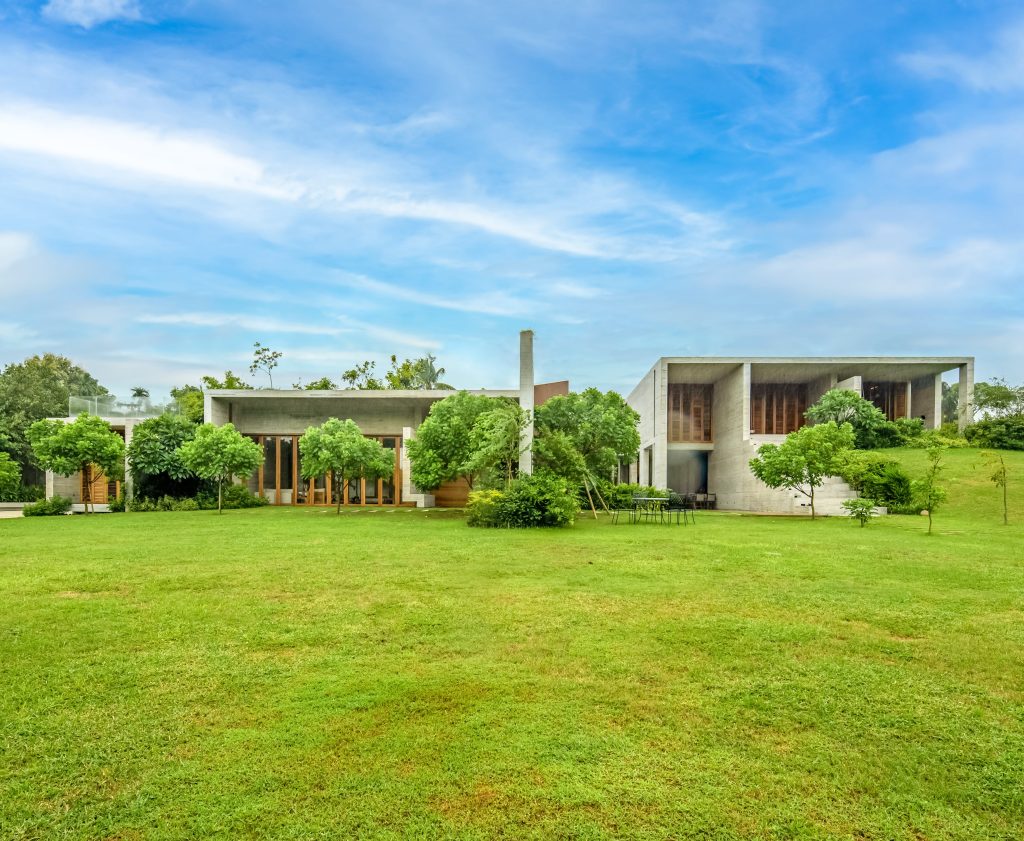
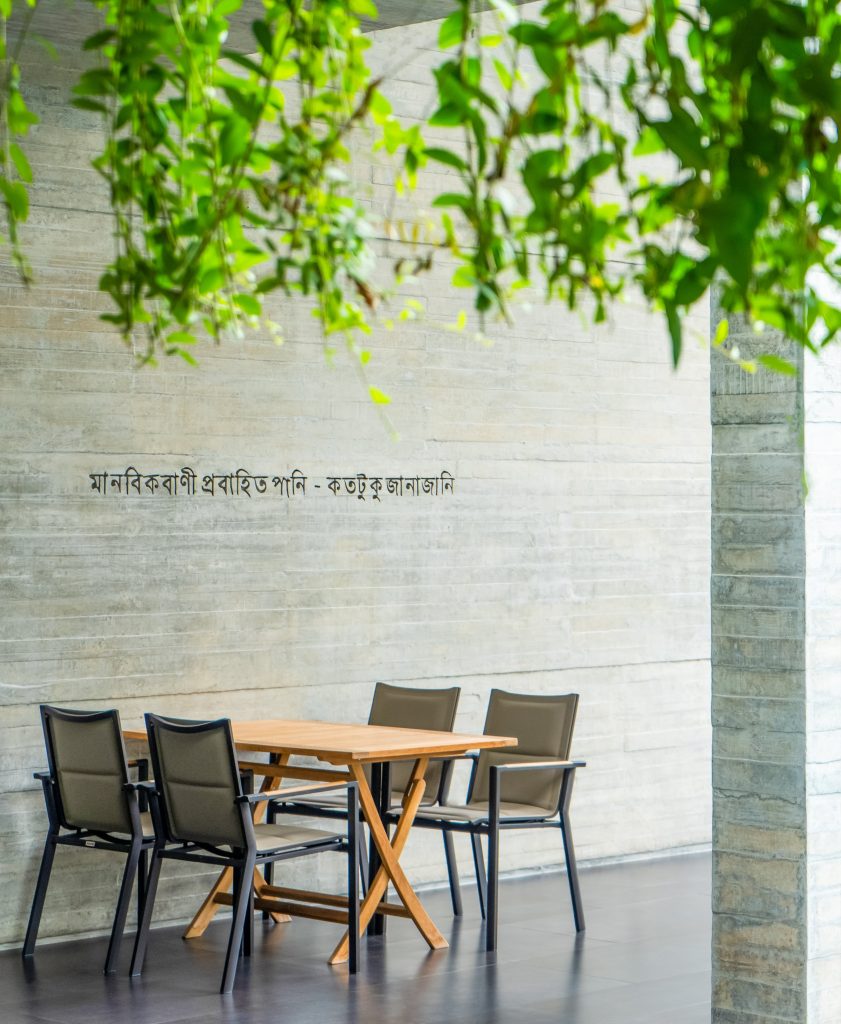
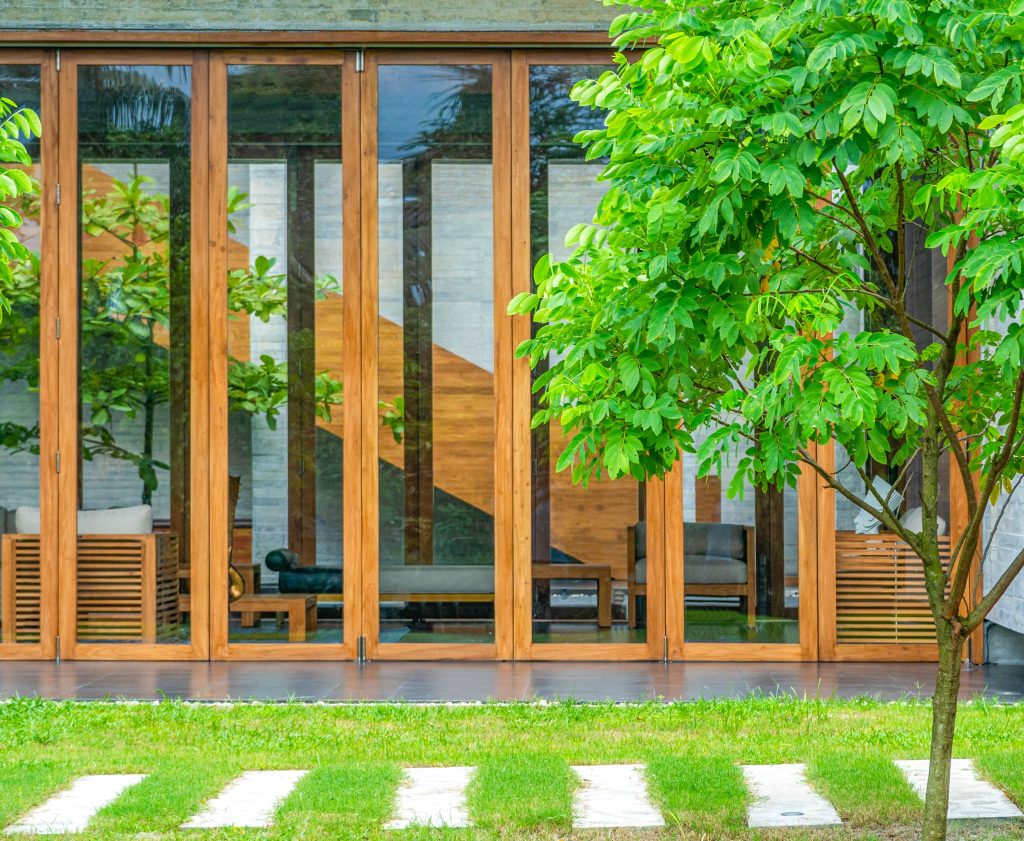
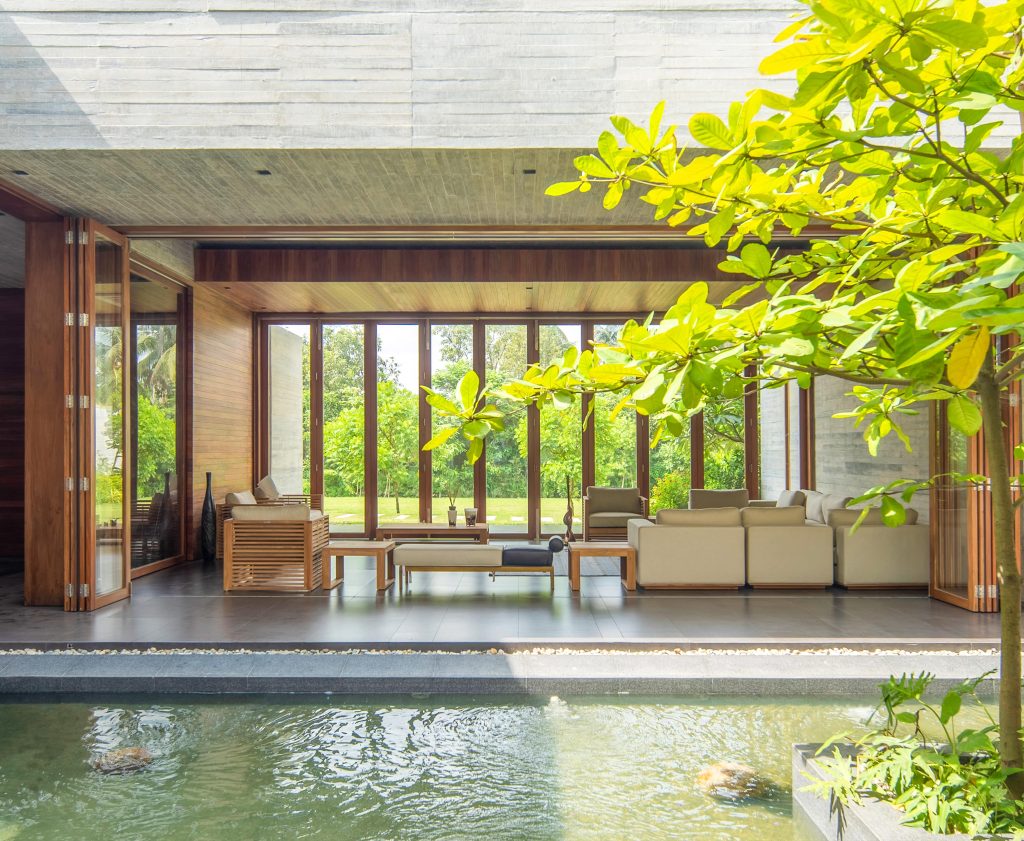
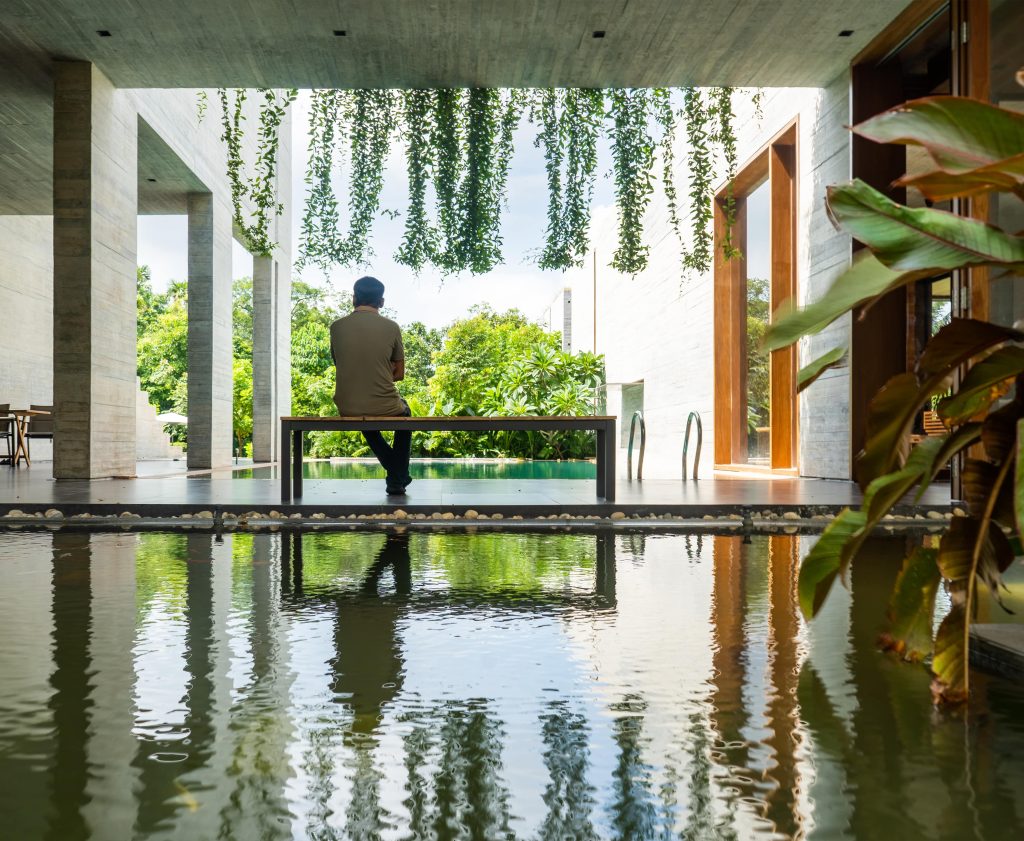
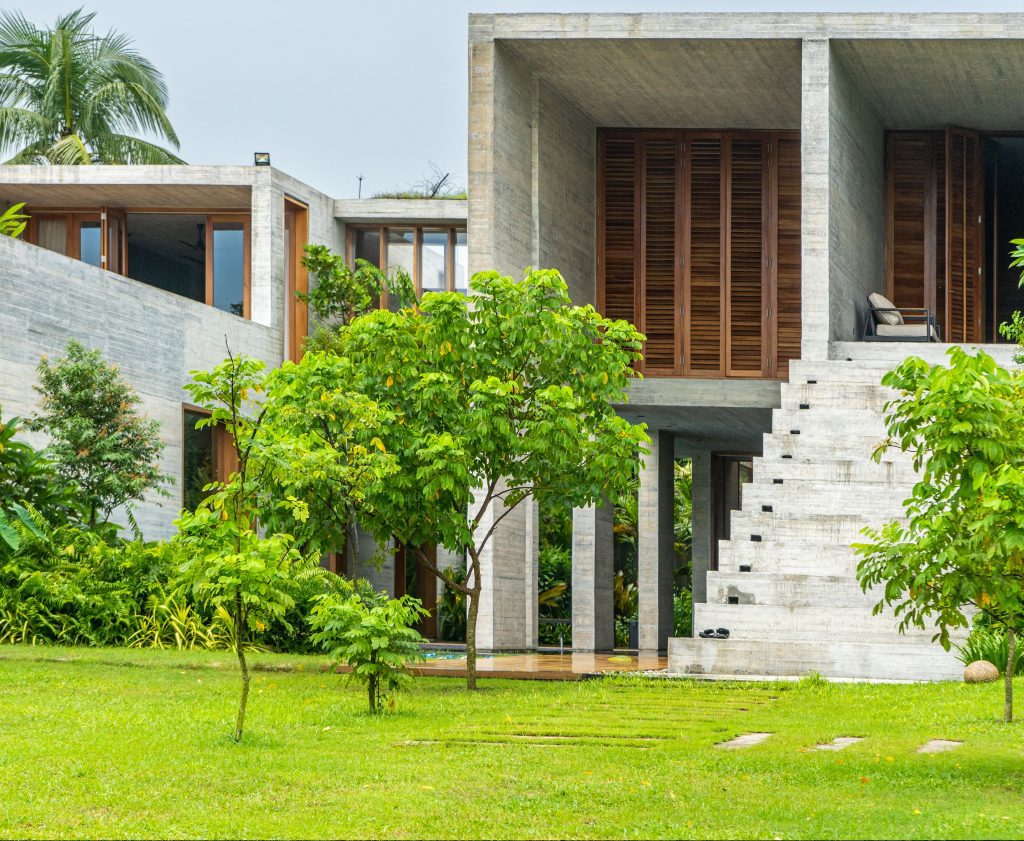
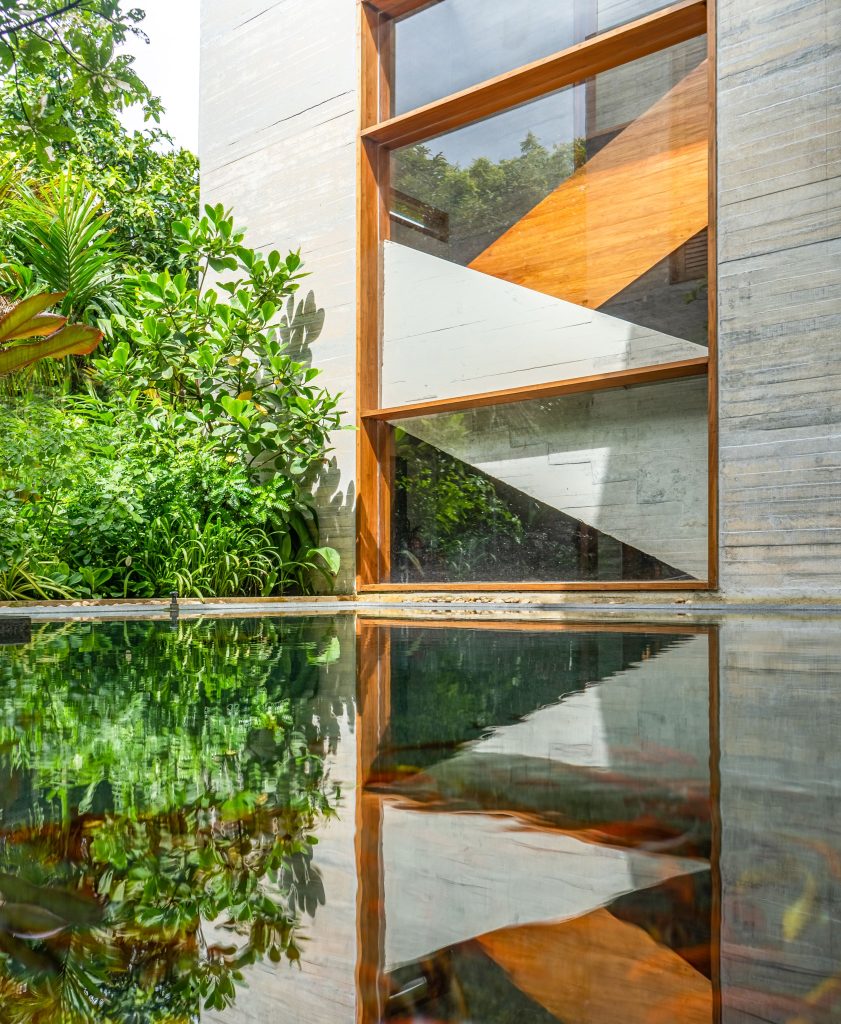
Spanning across 1035 square meters, CHAABI beckons visitors with its seamless blend of indoor and outdoor realms. Lead Architect of SYSTEM Architects- EKNC Enamul Karim Nirjhar envisioned a dwelling where the boundaries between inside and outside blur, inviting the inhabitants to explore the unknown and embrace the truth with a play of space.
As you step through the main entrance, a sense of warmth and hospitality envelops you, while other entrances seamlessly merge with nature, inviting the outdoors in. Bedrooms, a home theatre, dining room, swimming pool, gym, and more adorn the ground floor, each space bathed in the gentle glow of filtered daylight. The water body beside the living room mirrors the sky above, offering a serene backdrop for moments of contemplation.
But it’s not just the physical elements that define CHAABI; it’s the thoughtful details woven into its fabric. An invisible wall, an illusion to be felt rather than seen with a big door. Beneath the glass floor lie relics of the client’s father, holds within it the cherished memories of generations past preserving the essence of family heritage.
Two staircases, aptly named ‘tana,’ and ‘mana’ guide occupants through the residence, each step a journey through time and space. Light-filled stairways connect the interior to the landscape outside, evoking the sensation of walking through lush green fields. Ascending to the first floor, one discovers an intimate family area where rain is not just weather but a cherished companion.
A door opens to an outdoor oasis, inviting residents to revel in the soothing rhythm of the rain.
Here, amidst guest rooms and cozy nooks, lies the heart of CHAABI—the family living room, adorned with an address-desk, a wooden stage where voices are raised and memories are made.
The design ethos of CHAABI is a statement of architect; with a believe – Form follows fiction.
It’s a homage to nature and a celebration of materiality. Concrete walls stand as stoic sentinels, while mahogany wood infuses warmth and character into every door and window. Unobstructed glass panels invite the sun’s gentle caress, while matte tiles underfoot offer a subtle elegance.
Emotion-laden elements, such as memory traps, dot the landscape, casting shadows of remembrance and reflection. Here, amidst ambient light and whispered echoes, the past intertwines with the present, reminding inhabitants of the stories that shape their lives. At its core,
CHAABI is more than just a residence; it’s a sanctuary for the soul.
Every space, every material, every detail is imbued with a sense of peace and calmness, inviting residents to harmonize with their surroundings.
CHAABI is not just a structure; it’s the architect’s statement after exploring the client’s expectations and emotions.
And like any masterpiece, its beauty lies not just in its form, but in the emotions it evokes and the stories it tells.
As the sun sets over CHAABI, casting a golden glow across its tranquil landscape, one cannot help but marvel at the timeless beauty of Enamul Karim Nirjhar’s architectural masterpiece. With each passing moment, the residence reveals new facets of its personality, inviting residents to embark on a journey of discovery and introspection.
Beyond its physical attributes, CHAABI serves as a testament to the power of architecture to transcend mere functionality and elevate the human experience. Through its thoughtful design and meticulous attention to detail, it creates a sanctuary where moments of serenity and connection abound.
For Enamul Karim Nirjhar, CHAABI represents more than just another project; it’s a labor of love and a testament to his unwavering commitment to excellence. From its inception to its completion, every decision was guided by a singular vision: to create a space that not only meets the needs of its inhabitants but also nourishes their souls.
As residents move through its hallowed halls and verdant gardens, they are reminded of the inherent beauty of life and the importance of cherishing each moment. In a world filled with chaos and uncertainty, CHAABI stands as a beacon of hope and tranquility, offering solace to all who enter its embrace.
In the end, CHAABI is more than just a residence; it’s a testament to the transformative power of architecture to inspire, uplift, and unite us all. As its doors open to welcome a new generation of occupants, may they find comfort in its embrace and joy in its beauty for years to come.
2. A Unique Blend of Tradition and Contemporary Artistry – Hotel Nandini, Dhanmondi
Hotel Nandini was formerly known as Hotel Nidmahal. In the past, due to its poor management, the establishment failed to initiate its admiration. As a result, it gradually got converted into a bank, an office as well as a branch of a university. This intimate scaled boutique hotel underwent a massive renovation renovated by Nakshabid Architects to achieve a significant facelift that adds dynamicity to the surrounding urban texture. Currently, with a long-term lease agreement, the plot has been reestablished by transforming the first two stories into a flagship store, one floor dedicated to office space, and the rest of the floors as a three-star boutique hotel with its necessary facilities. The roof space has been transformed into a beautifully designed dining facility with a view of the urban skyline.
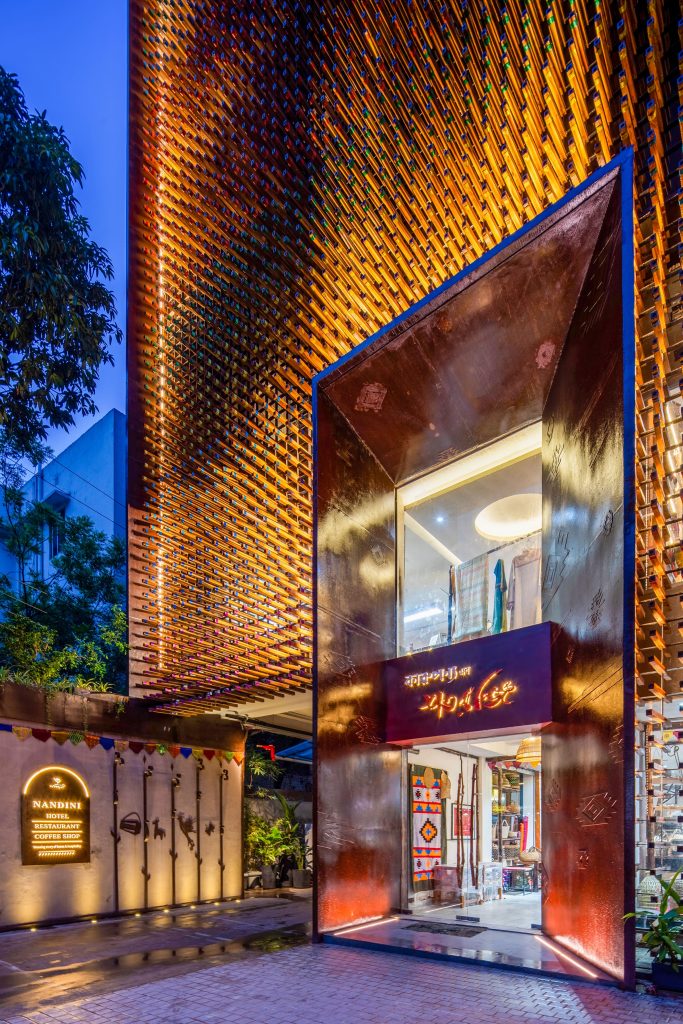
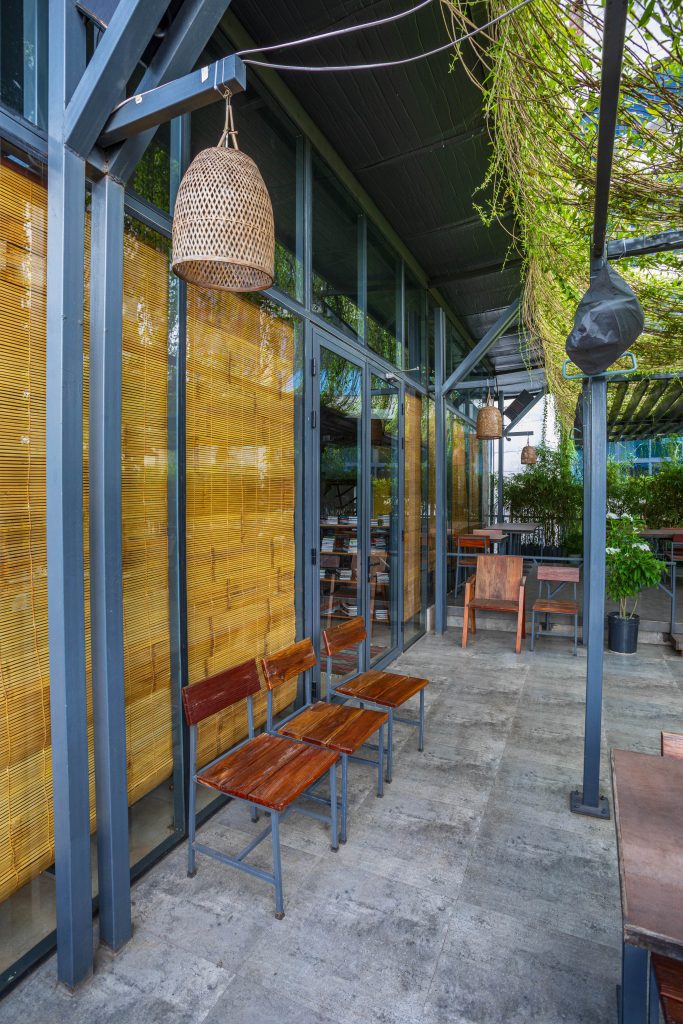
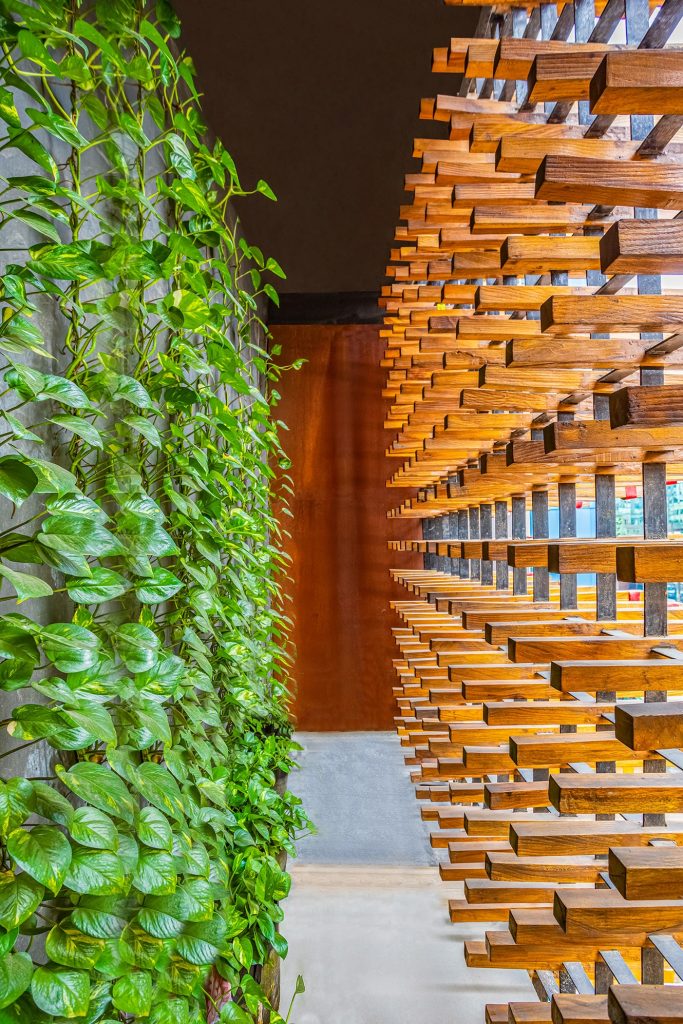
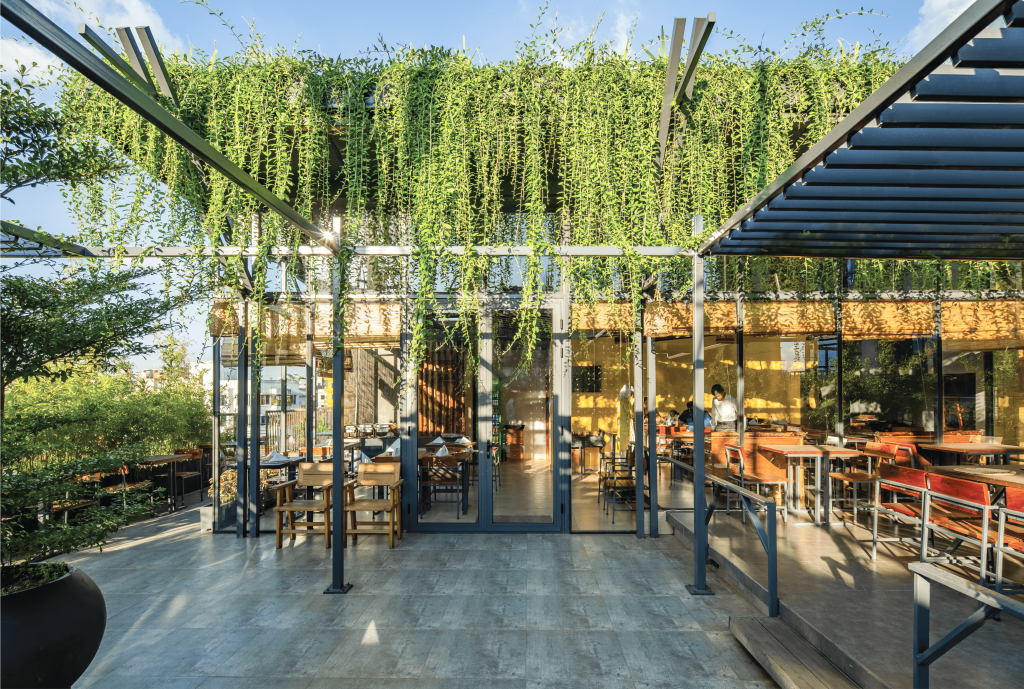
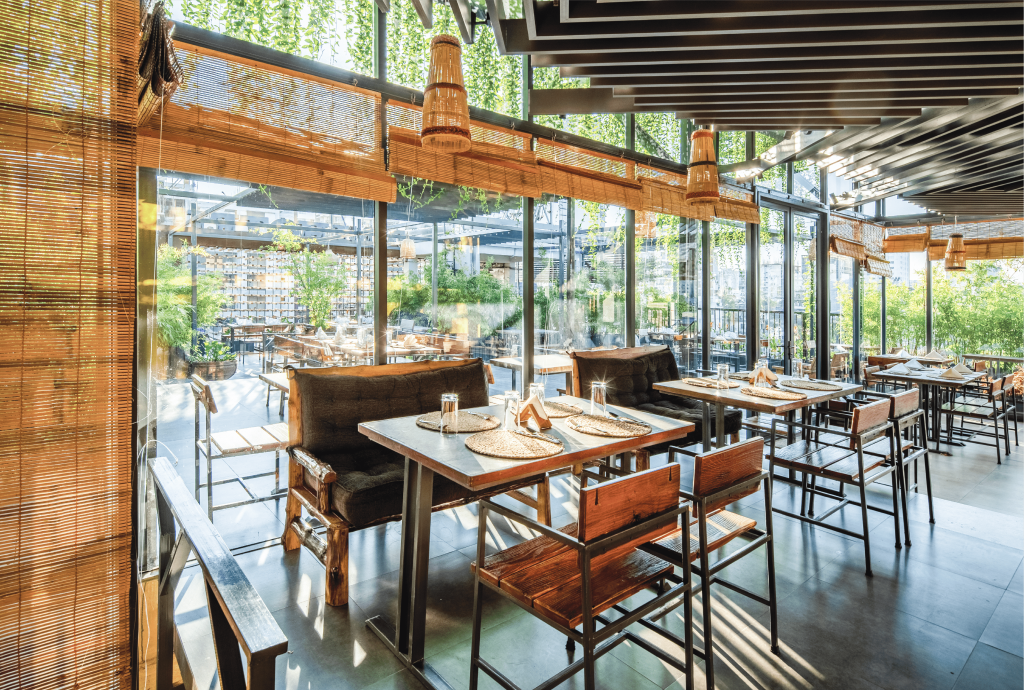
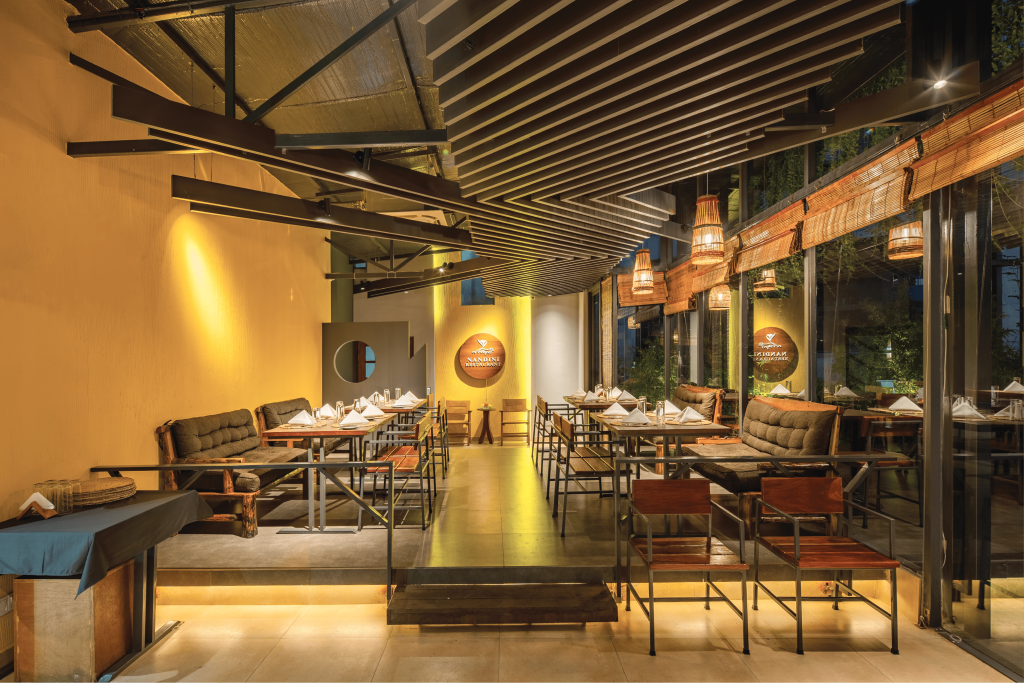
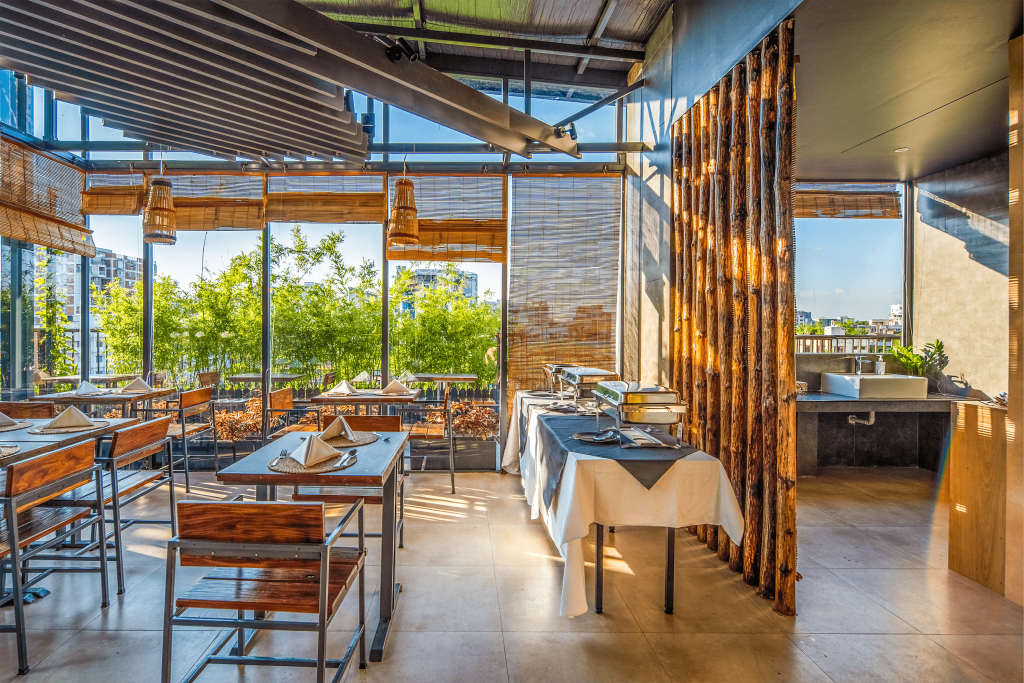
The project is led by Ar. Bayejid Mahbub Khondker and codesigned by Ar. Subrata S Hazra, Artist Rainy Wadud and Ar. Ajoy Das. By ditching mechanical procedures, the entire establishment has been manually hand-painted to present the real texture of manual handwork. The handwork distinctively beautified the appearance of the Nandini Hotel in a way that it has become a treat to the eyes of people. The building was built in a 10×10 grid frame structure. The old floor finishes have all been removed and replaced with a minimalistic concrete finish, for getting rid of the added thickness of the floor. Locally seasoned wood Koroi, Gaab, Sea Grass, and Bamboo have been used for interior work. A small volume of steel has been imported which was locally weathered. The building was at its optimum; hence further loading was not structurally feasible. Therefore, the materials selected are all lightly weighted. The building was built in a 10×10 grid frame structure.
What makes the building unique is its positioning; the remarkable setback from the adjacent road. Hence, the focus is given to the entryway. It is a narrow space but has been made grand with a bigger scale ceiling height. One of the major challenges was that the building was exposed to the west. Commonly, in tropical areas solidification is appreciated with screening. The target here was to create a solid plane with tons of points, which is breathable at the same time. The light passing through will create shadow in multiple layers. This guarantees unhindered visibility and cuts off the direct western rays simultaneously.

The entire building’s nighttime illumination is so spectacular that it appears to be shimmering like thousands of enormous stars in the night sky. Moreover, such aesthetic idea of blending glass and wooden crafting has not been presented to people before and it also became eye-catching to every passerby. On the left side of the hotel, the branding work has been done using raw wooden crafts. 2.5 feet of wooden sticks have been placed at a distance of 8 inches from each other in the form of a cross which is attached with screws creating a kind of wooden rowing illusion. The rooftop restaurant is decorated with greenery and traditional wood-crafted accessories which enhances the Bengali tradition. It is consisting of two parts. One side is enclosed with glass and air-conditioned, and the rest of the space is open-to-sky dining. The only setback is its orientation. Because the mass is facing west and located beside one of the busiest primary roads, the heat and the noise pollution often get overwhelming.
Nandini Hotel gives a comfortable, homely atmosphere to the guests. Everything in this hotel that is visible is handcrafted, allowing us to see a reflection of our culture. To maintain an authentic feel, both the interior and exterior utilize native materials.
3. Track Tales to Skyline Stories
In the coastal haven of Cox’s Bazar, where the sun meets the sea and the breeze whispers tales of the Bay of Bengal, a new landmark stands tall, echoing the brilliance of architect Mohammad Foyez Ullah. The Cox’s Bazar Railway Station, officially inaugurated on November 11, 2023, is more than just a transportation hub; it is a testament to architectural innovation and a harmonious blend of form and function.
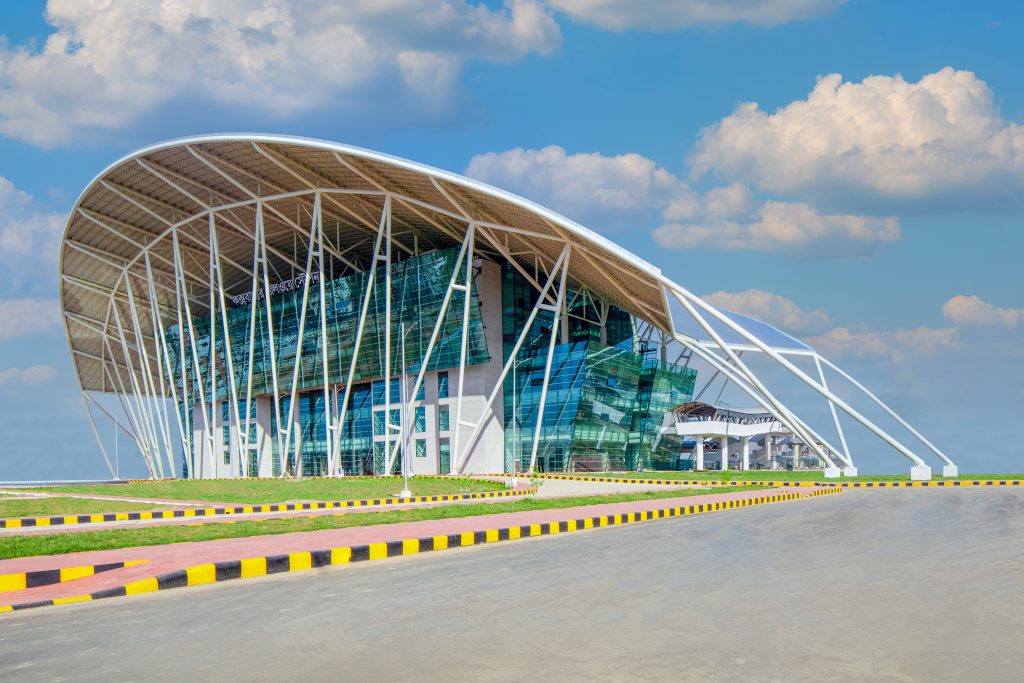
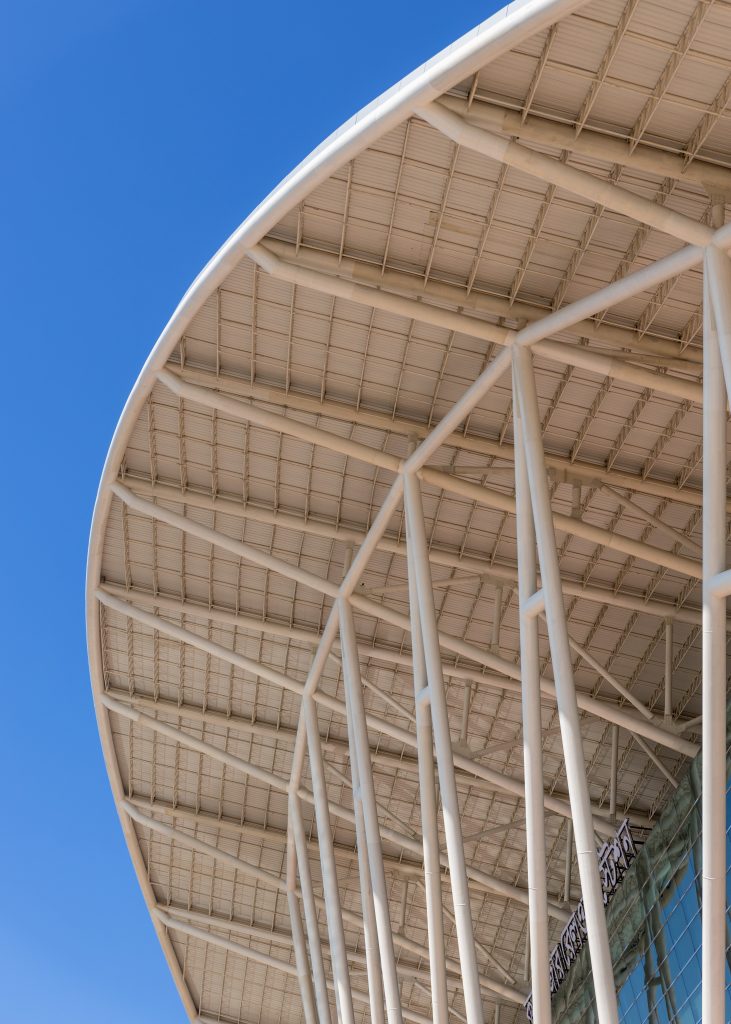
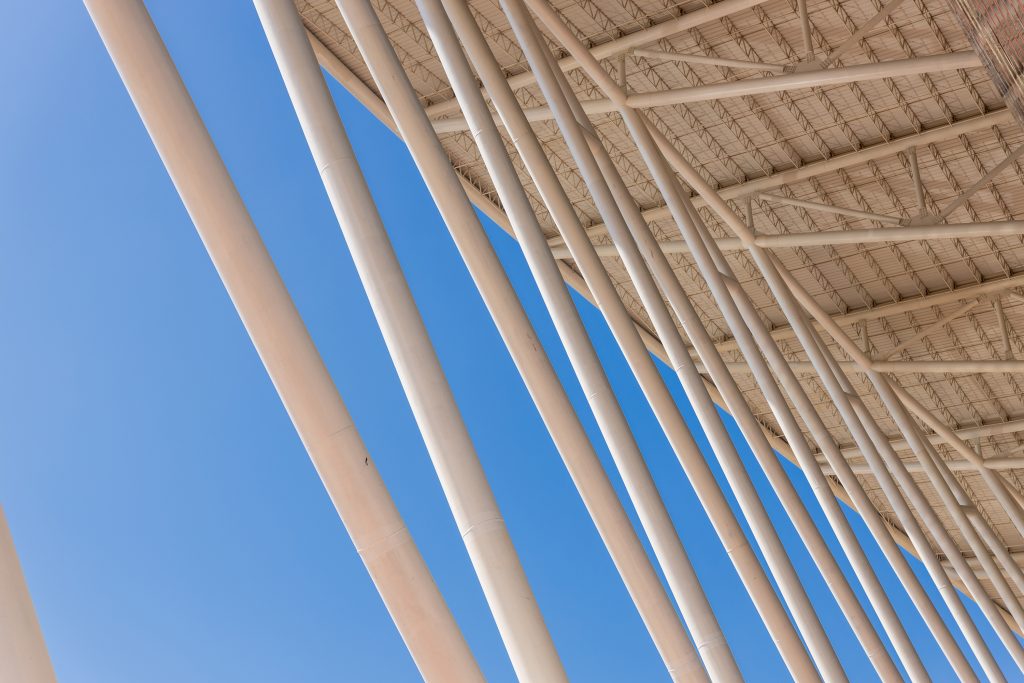
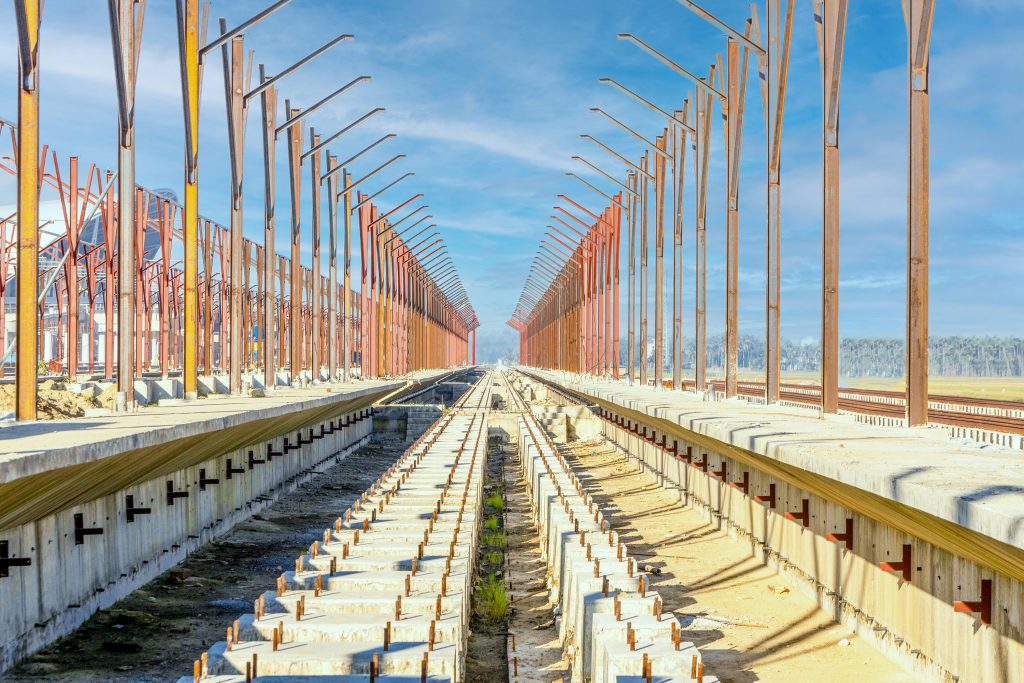
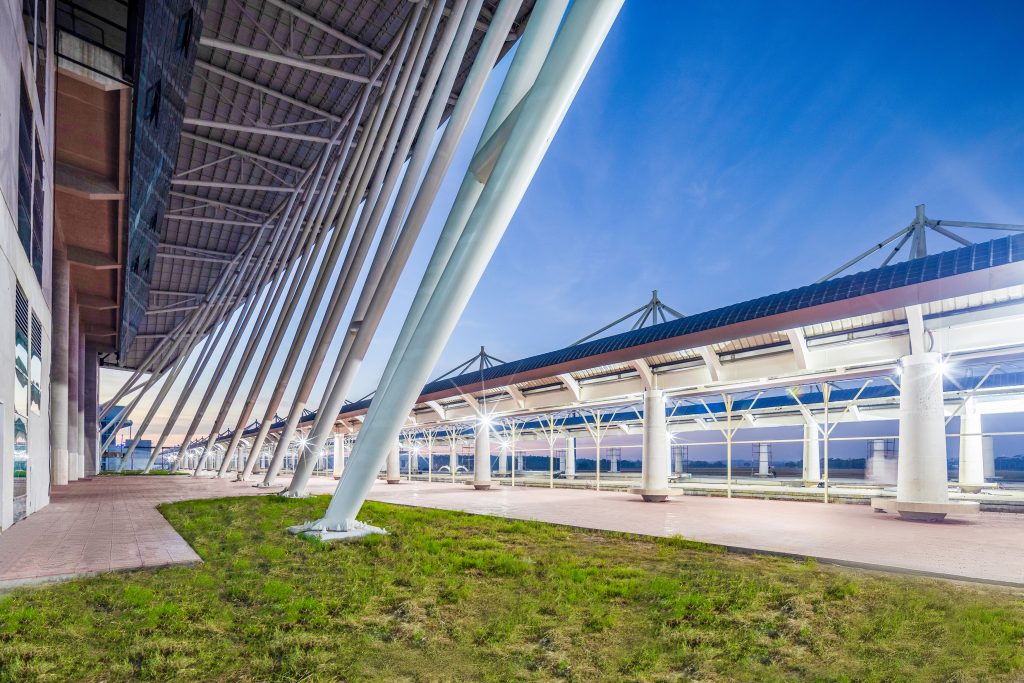
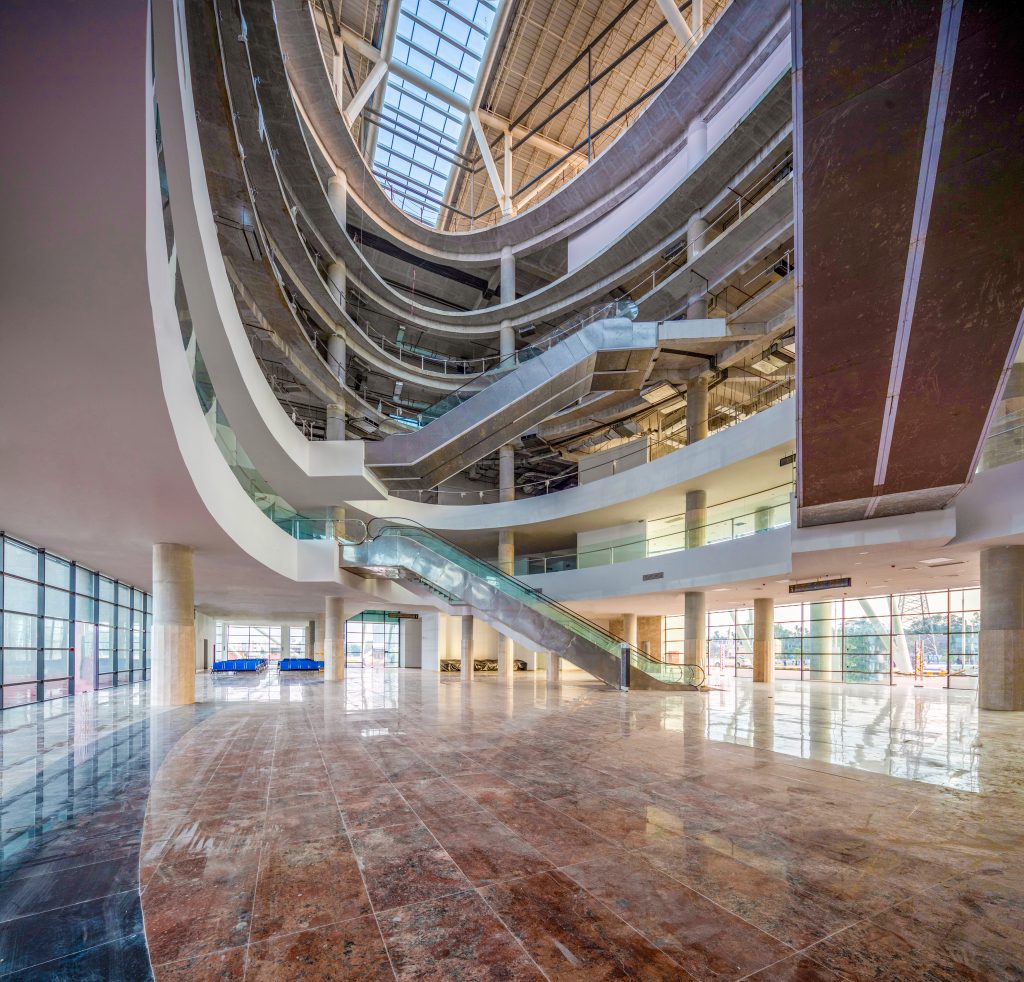
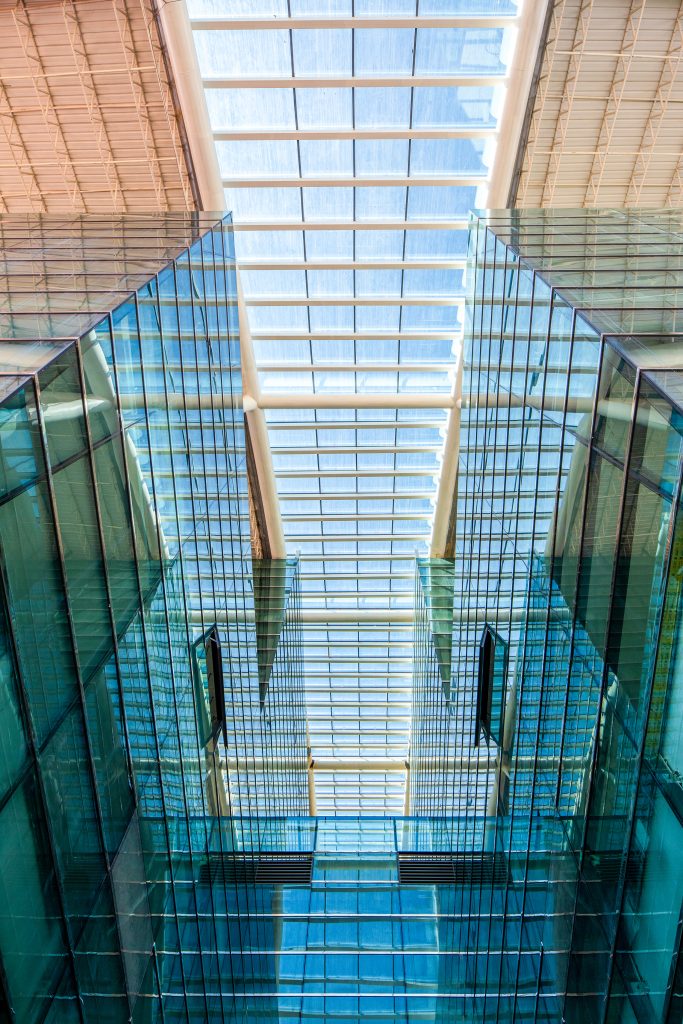
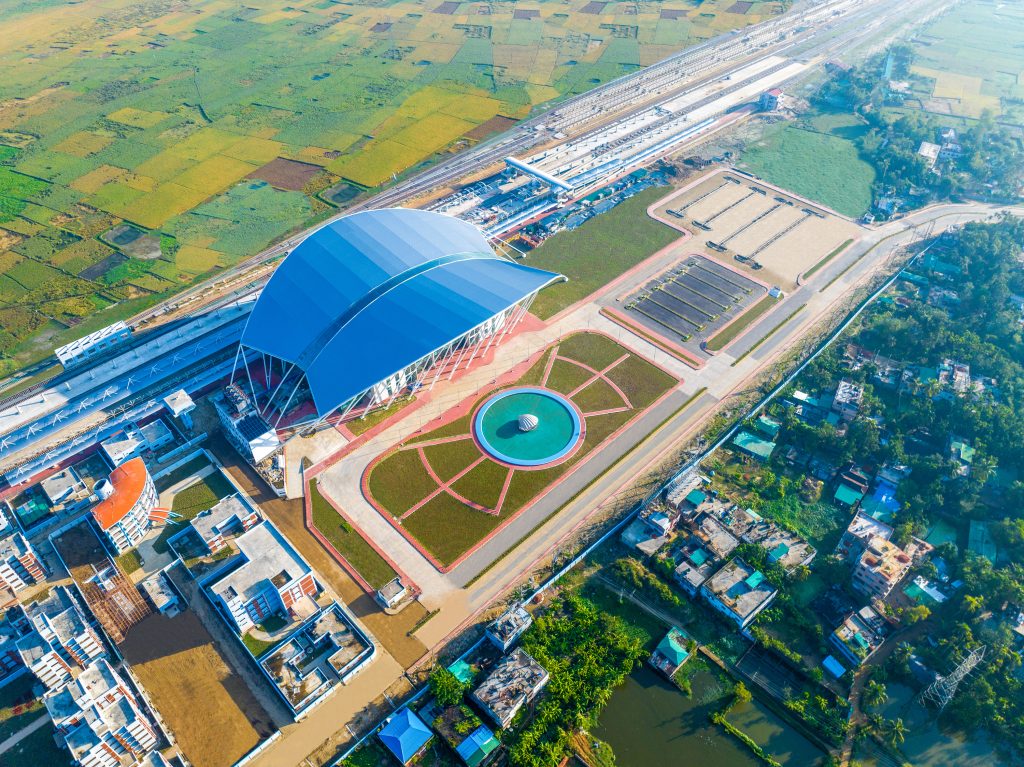
At the helm of this visionary project is the indomitable endeavor of the leading architectural practice of the country, Volumezerto Ltd, under the leadership of the charismatic Mohammad Foyez Ullah. Foyez Ullah has singlehandedly shaped the contemporary architectural landscape of the country through his various endeavors. He was an educator at the Department of Architecture, BUET from 1994 to 1998. He was the co-founder of Vistaraa Architects and later regenerated his practice through Volumezero Ltd. Bashundhara City, The Westin, and Grameen phone headquarters are among the era-defining pieces of architecture that have shaped our cityscape. They are among the vast repertoire of excellence in Foyez Ullah’s portfolio.
The Cox’s Bazar Railway Station, a brainchild of Mohammad Foyez Ullah, stands as the first iconic railway station in Bangladesh, proudly reflecting the cultural heritage and resilience of the nation. The architectural marvel unfolds over six stories, covering an impressive 11.8 hectares with a built-up area of approximately 200,000 square feet.
In a contemporary twist, Mohammad Foyez Ullah translates this heritage into a modern railway station that not only pays homage to tradition but also embraces functionality and sustainability. The construction of this grand project commenced in 2020 and concluded in 2023. However, the journey was not without its share of challenges. The global pandemic, COVID-19, posed a formidable obstacle, creating a crisis that demanded resilience and adaptability from the design team. The construction team faced the monumental task of erecting a massive metal canopy spanning 120,000 square feet, utilizing local technology and manpower. Despite adversities, the station stands tall as a symbol of triumph over challenges.
The Cox’s Bazar Railway Station is more than a transit point; it is a modern intermodal gateway to the tourist heaven of Cox’s Bazar.
With a daily footfall of 46,500 passengers and 2,000 visitors, the station operates seamlessly with 80 staff members overseeing its myriad functions. From waiting areas and luggage storage to a children’s playground and hotel rooms, the station caters to diverse needs.
The parasol roof is not only an aesthetic element but also a functional one.
Its curvilinear design represents the sea, weaving in the essence of Cox’s Bazar. The raised and multifunctional roof protects from the sun, sea winds, and rain while ingeniously collecting rainwater for sustainable reuse.
Mohammad Foyez Ullah’s commitment to sustainability echoes throughout the station’s design. LED energy-efficient lighting, solar power utilization, rainwater harvesting, and the use of sustainable materials showcase a conscientious approach. High-performance external glazing, natural light integration, and low water flow fittings contribute to an environmentally responsible structure.
The exterior facade of the Cox’s Bazar Railway Station is a masterpiece in itself.
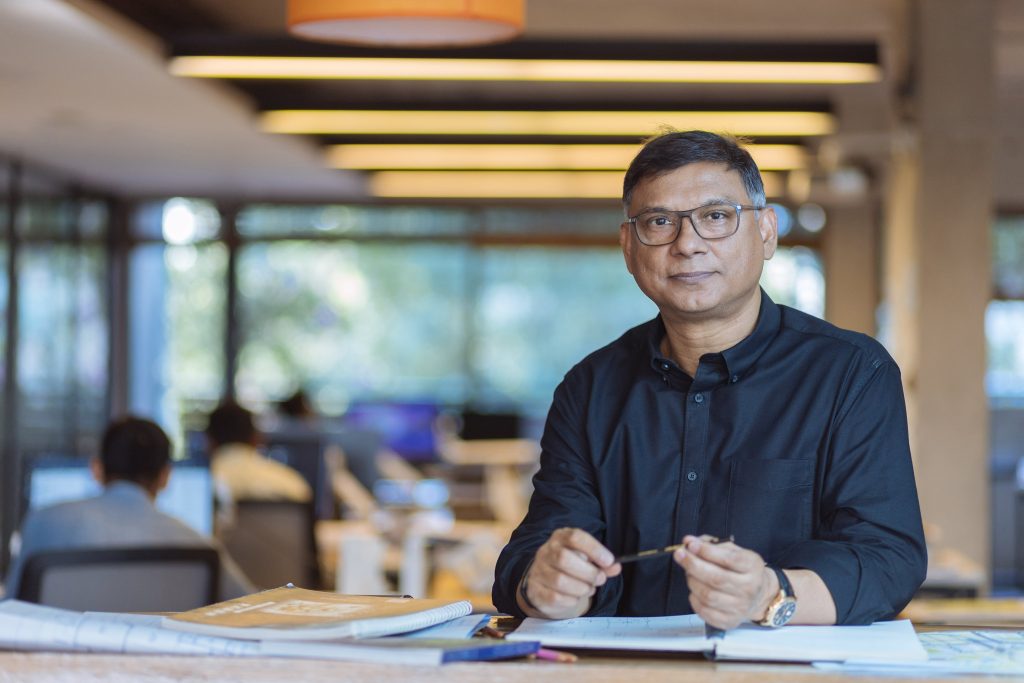
A semi-unitized structural silicone glazing system, adorned with double-glazed Low-E coated panes and aluminum Bullnose, adds a touch of modern elegance. High-performance external glazing with a curtain wall system, along with industrial sheet-covered MS tubes for the canopy, highlights the fusion of aesthetics and functionality.
The colossal canopy, platform shed and the mesmerizing Pearl Featured Sculpture stand as testaments to Mohammad Foyez Ullah’s meticulous attention to detail and commitment to creating a sensory experience for visitors.
Spanning 11.8 hectares, the Cox’s Bazar Railway Station is housed within a six-storied building covering approximately 200,000 square feet. The sheer scale of the project is a reflection of Ullah’s ambition to create not just a railway station but an architectural masterpiece that transcends boundaries.
In the heart of Cox’s Bazar, Mohammad Foyez Ullah has woven a narrative of architectural excellence with the Cox’s Bazar Railway Station. This transcendent structure not only redefines the landscape but also embodies the spirit of innovation, sustainability, and cultural homage. As trains traverse the tracks and passengers embark on journeys, the station stands as a living testament to the harmonious coexistence of tradition and modernity. Cox’s Bazar Railway Station is not just a transportation hub; it is a destination in itself, beckoning travelers to embark on a journey through time, culture, and architectural brilliance.
4. Rich Spatial Composition – Reaz Residence, Narayanganj
Reaz residence, a triplex home in Narayanganj city designed by DWm4 Architects, is gracefully minimalist and filled with meticulous detailing. The residence is compassionately designed to connect and create a sequence with the surrounding environment by large panel windows and open terraces that aid in diminishing the barrier between inside and out, while high ceilings/lofty spaces enhance the sense of space and tranquility.
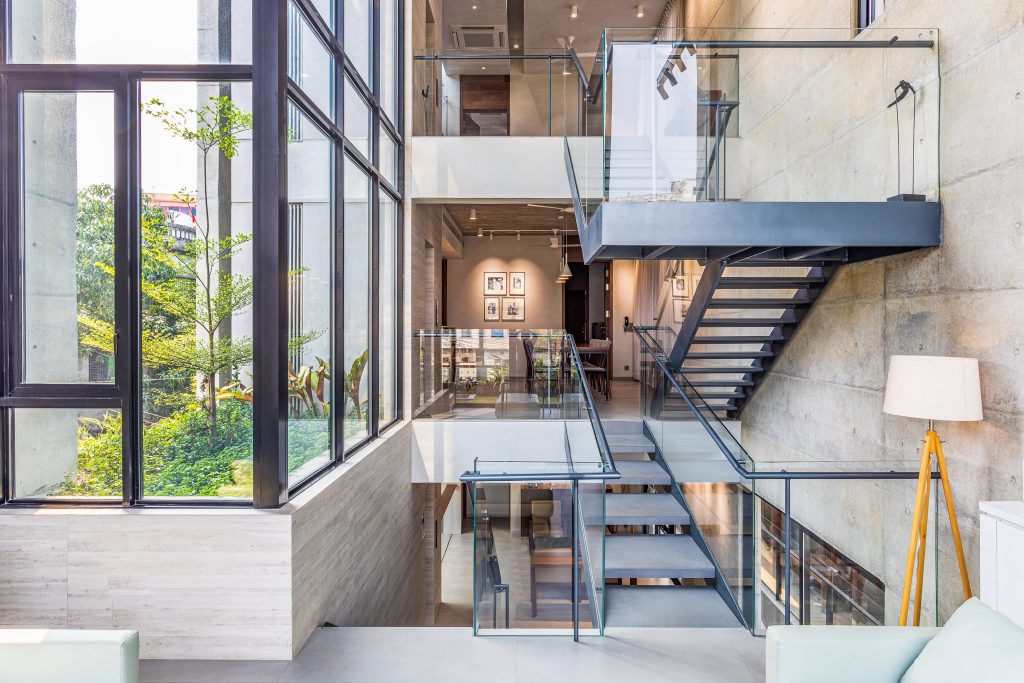
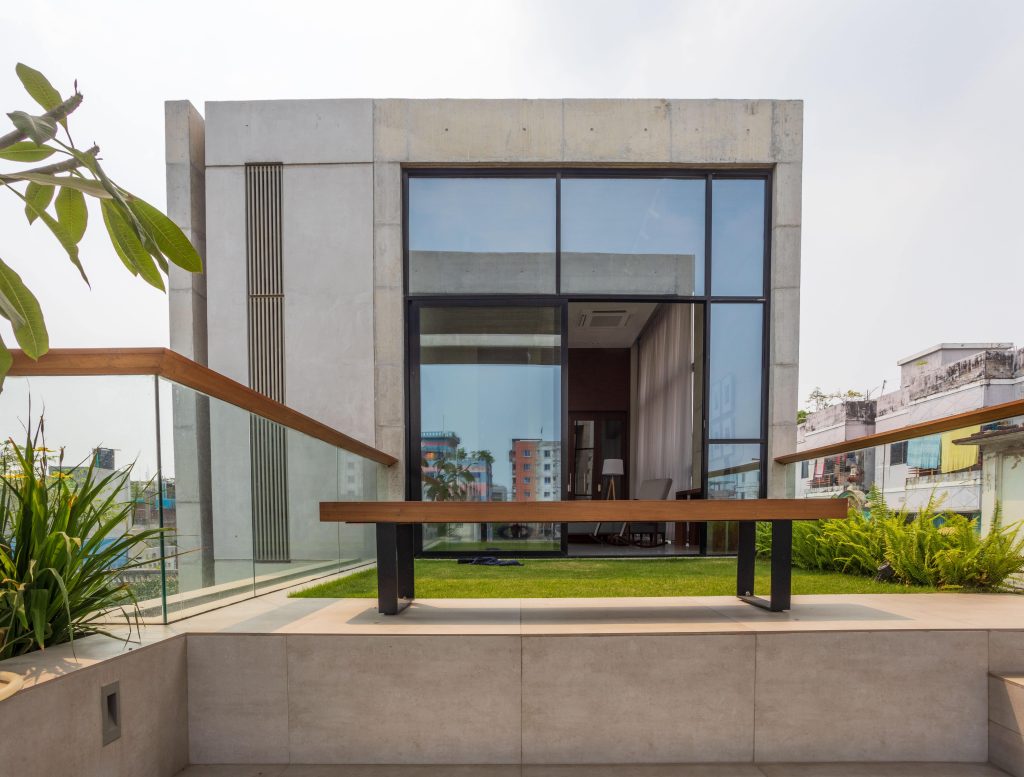
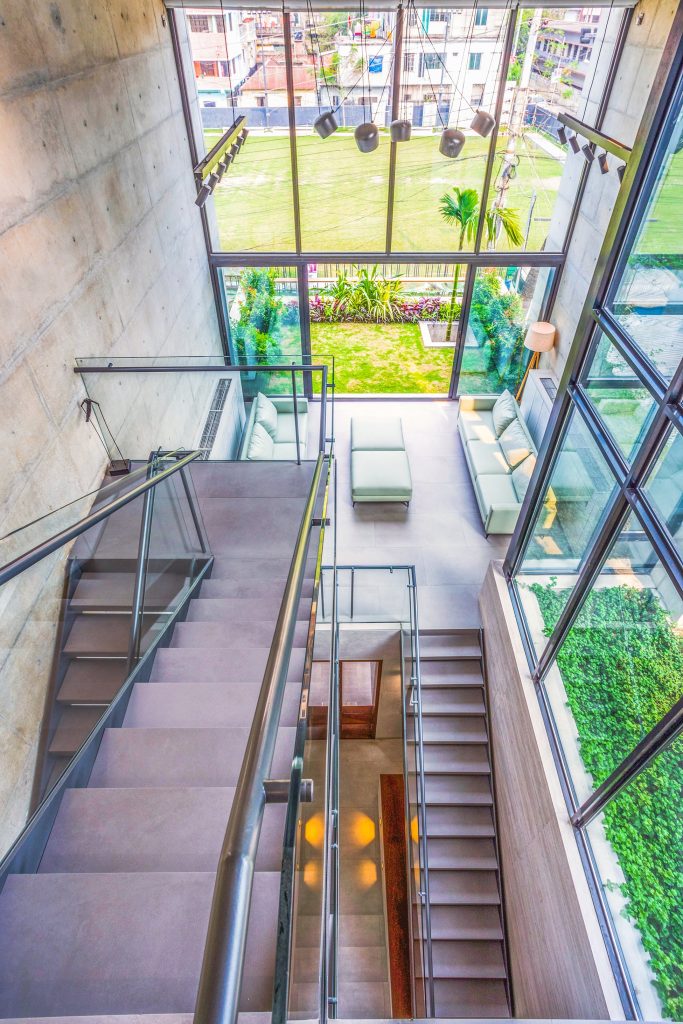
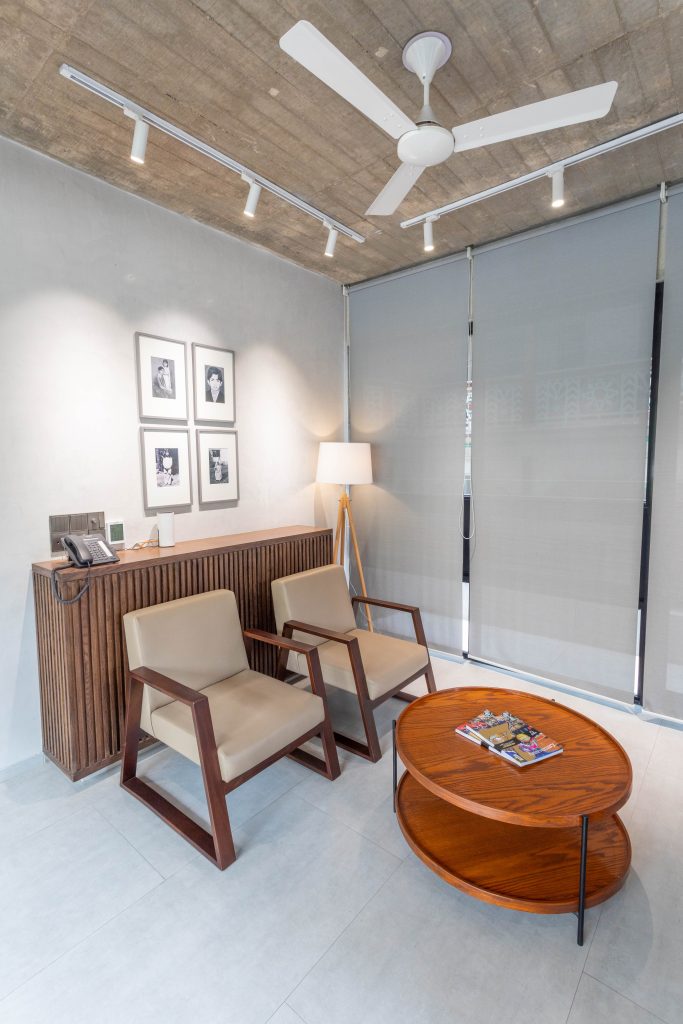
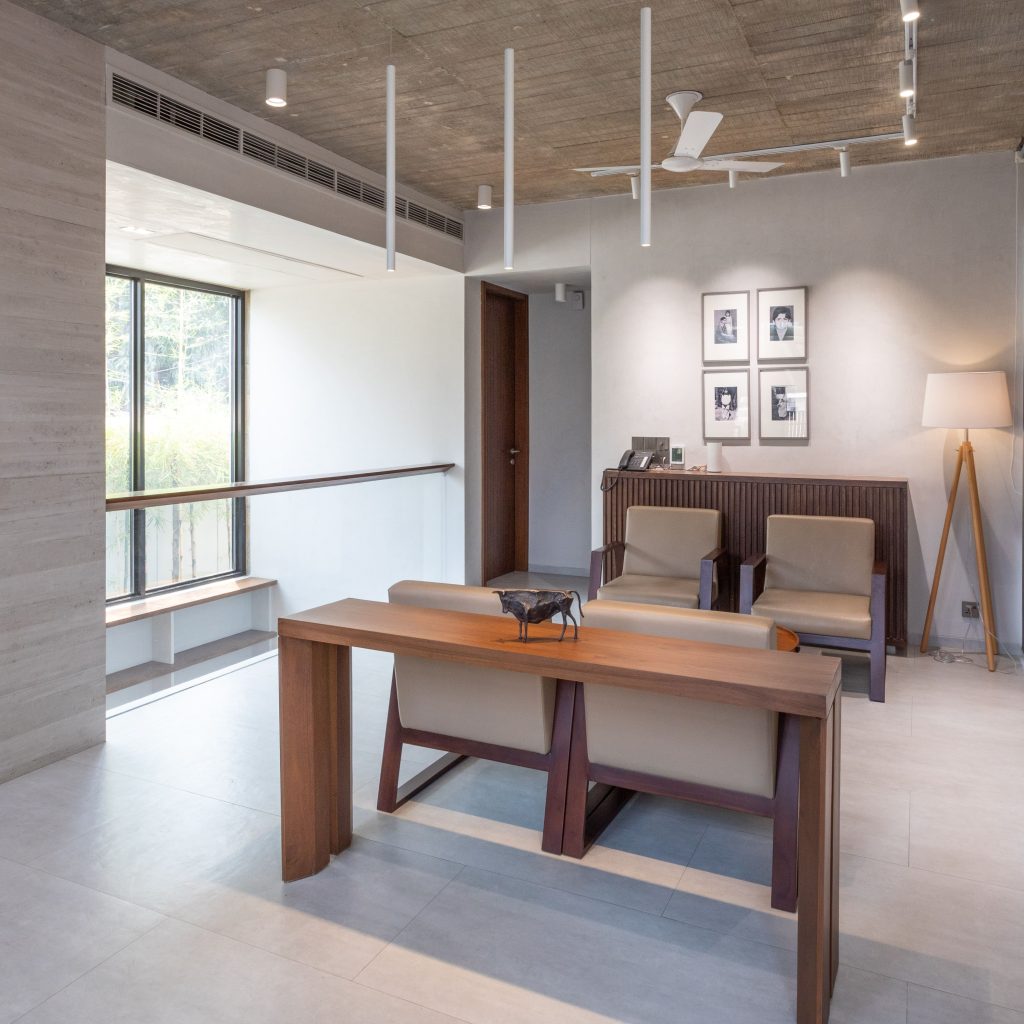
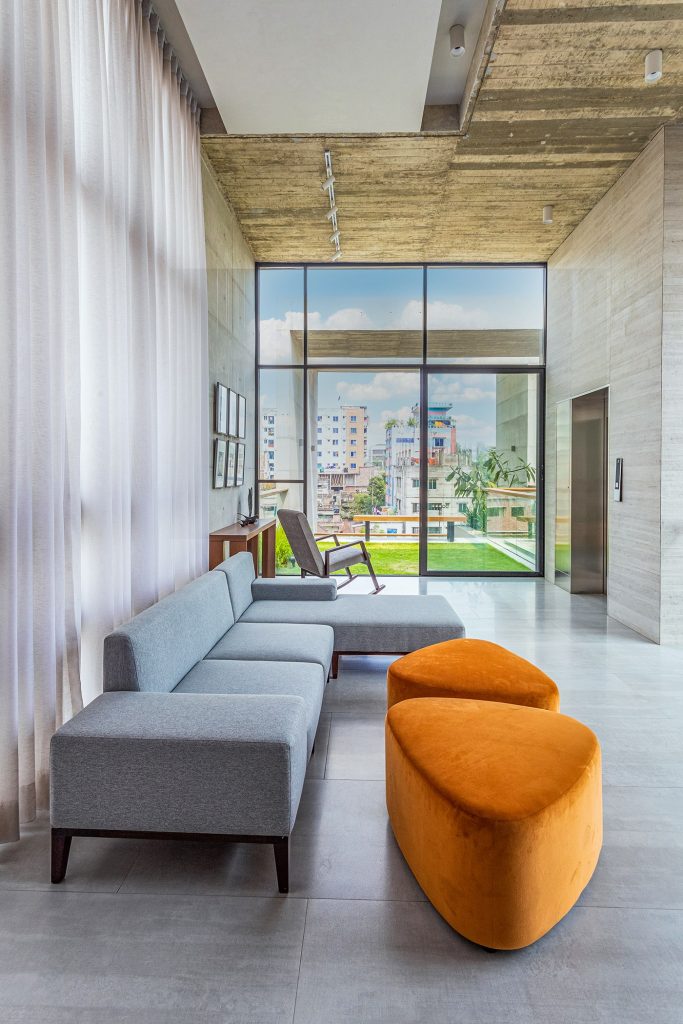
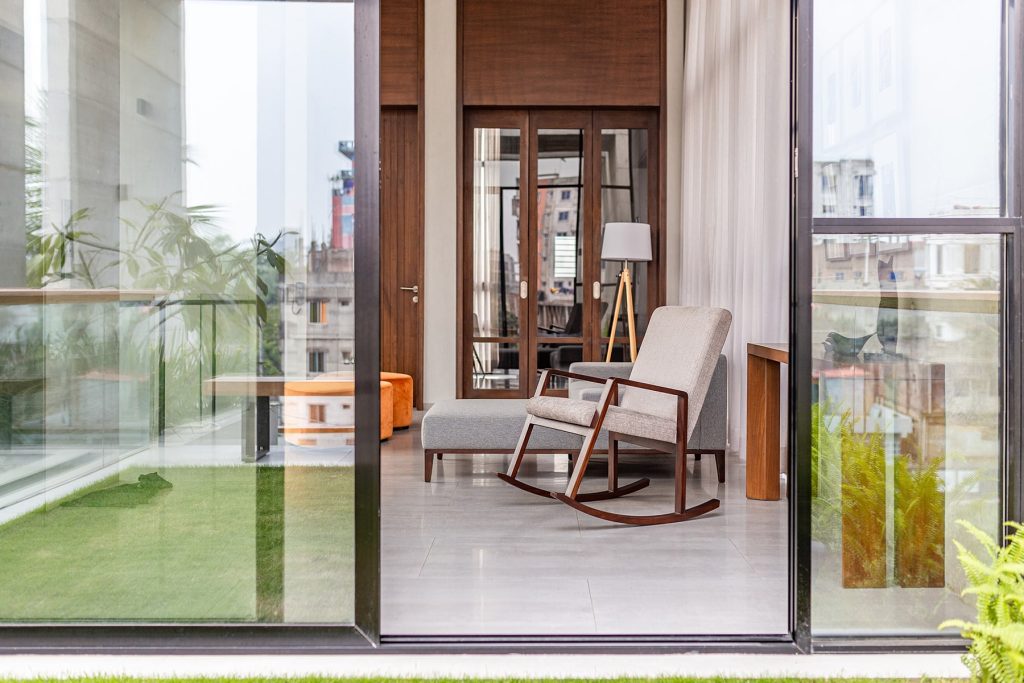
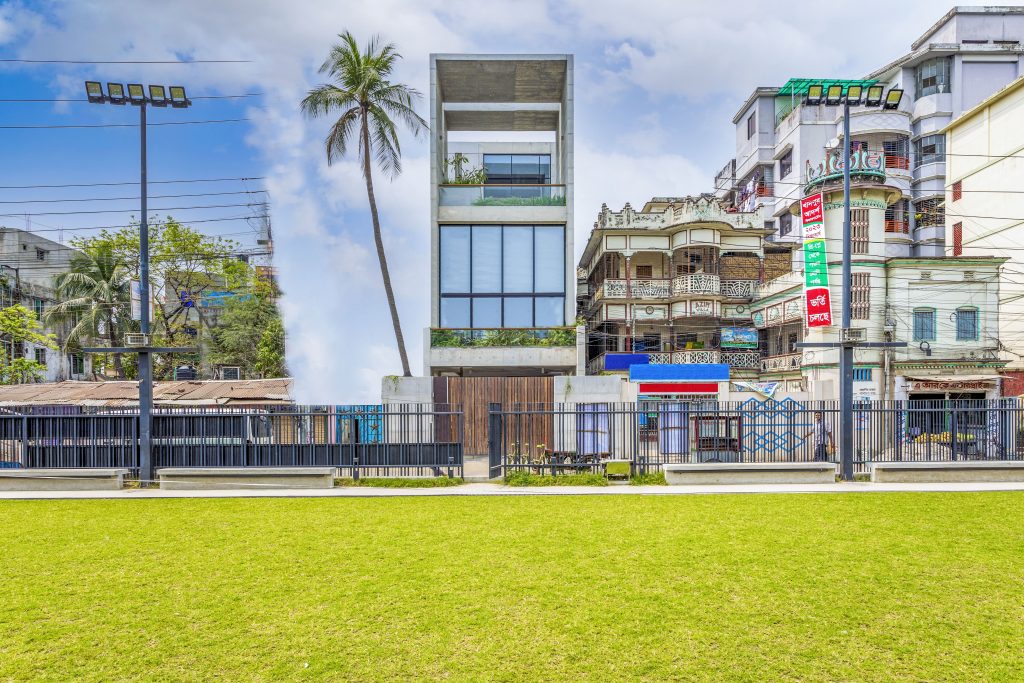
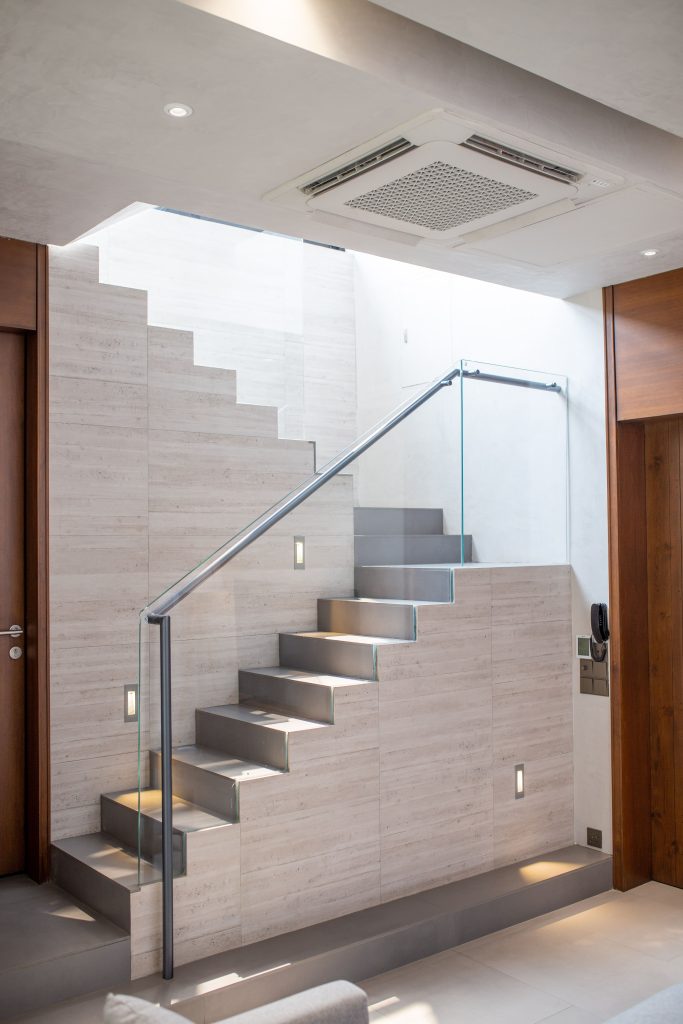
The residence is set adjacent to a large field that holds many special memories of the client since his childhood. The residence plot was received by the client from his grandmother, and he wanted to relive the memories by witnessing the daily activities and sports that take place in the field from his residence. The residence is therefore designed in a way that embraces the exterior views with fine transparency, emphasizing the client’s emotional connection to the field. Conceptually, the residence is designed to be a humble presence on the site, a backdrop for the field, rather than an intimidating contrast. The use of concrete, glass, and steel as primary materials resulted in a muted color tone while the ample amount of natural light that is brought into the house creates an ever-changing drama of light and shade over time.
The design team behind the project were: Mahmudul Anwar Riyaad, Principal Architects of DWm4, Mamnoon Murshed Chowdhury, and Shaoki Shamim, Partner Architects of DWm4 and Md. Obidur Rahman Rajib, Sr. Architect of DWm4. Speaking about the challenges of the project, the design team shares, “The constraint of the project’s construction was mainly COVID-19. The process was severely prolonged due to the pandemic and the unavailability of materials and workers at that time. Nevertheless, the client and management team had complete faith in the design team and gave us the time and support to nurture the design and construction.” The whole process became so easygoing because of all the support and flexibility that the client provided. The freedom is so important for a creative work. Those who understand it are so appreciative.
“Since the plot is narrow, estimating only 20 feet in width, there was very little room for horizontal consistency, so we creatively played with the sectional aspect (verticality) of the building and carried out the construction with precision”
explains Architect Riyaad. The sculptural staircase is one such representation; vertically displaying creativity in a void of slanted layers. The residence is divided into four layers. The ground floor, the first and the second floor, and a basement. The basement consists of a lounge and book gallery, the ground floor to the second floor consists of public and semi-public functions (formal living, dining, guest rooms) while the topmost floor, is a private and cozy suite that is entirely designated to the owner. The floor is quiet, and peaceful and is more connected to the outdoors. It has a spacious lounge, gallery, and a special terrace cum amphitheater kind of space where the owner and his fellow mates can sit and enjoy the sports being played in the adjacent field. Interestingly, the terrace has a corner, especially, designed for the owner to sit and watch games profoundly.
Architect Mahmudul Anwar Riyaad believes it is important to take the client’s preferences and financial constraints into account when designing a space. He shares his design process and ideologies, saying, “Every project is unique in its way. Rather than employing a consistent style, I take inspiration from my surroundings, draw references from the context, and then approach the required design.” As a piece of advice to young architects, Riyaad shares “Like any other subject related to art, such as painting, music, or photography, architecture is a difficult subject to be embraced with perseverance. Anyone who wants to advance in the field must invest a significant amount of time in architecture and must be consistent.
” He views architecture as a part of culture and nature. Though man-made, the built environment remains a part of nature, so architecture and design should always pursue meaningful and experiential work for the greater good.

He believes throughout the years, the architecture scenario in Bangladesh has consistently overcome challenges and advanced toward development. He respects and admires the work of the architects in our nation who approach design from an ethical perspective.
Rooted in the client’s profound connection to the field, the design embraces transparency, blurring the boundaries between indoor comfort and outdoor vitality. Every corner of the residence resonates with the echoes of cherished childhood memories, as the client immerses himself in the vibrant tapestry of daily activities and sports unfolding before his eyes.
Symbolizing humility and reverence for the land, the residence emerges as a seamless extension of the natural landscape, embodying a sense of understated elegance. Concrete, glass, and steel converge to form a minimalist aesthetic, their muted tones echoing the quiet dignity of the field. Yet, within this simplicity lies a dynamic interplay of light and shadow, as sunlight dances across the interiors, casting ever-changing patterns of illumination and shadow.
In essence, the residence transcends its architectural form to become a sanctuary of introspection, a testament to the enduring bond between man and nature. As the client gazes out onto the familiar expanse of the field, he finds solace in the timeless rhythm of life unfolding before him, reaffirming the enduring power of place and memory in shaping our lives.
5. An Escape to Serenity
“Nirontor,” a tranquil haven located in Shariatpur, is just 85 kilometers from the bustling capital city of Dhaka. The elegantly understated residence sits in the middle of the quiet village of Naria, the client’s hometown, spanning 14,348 square meters with a total built-up area of 844 square meters. It serves as a sanctuary for the client’s family and cherished guests, offering respite from Dhaka’s urban intensity. Here, the name “Nirontor” was chosen to signify a generational connection to the ancestral roots of the client.
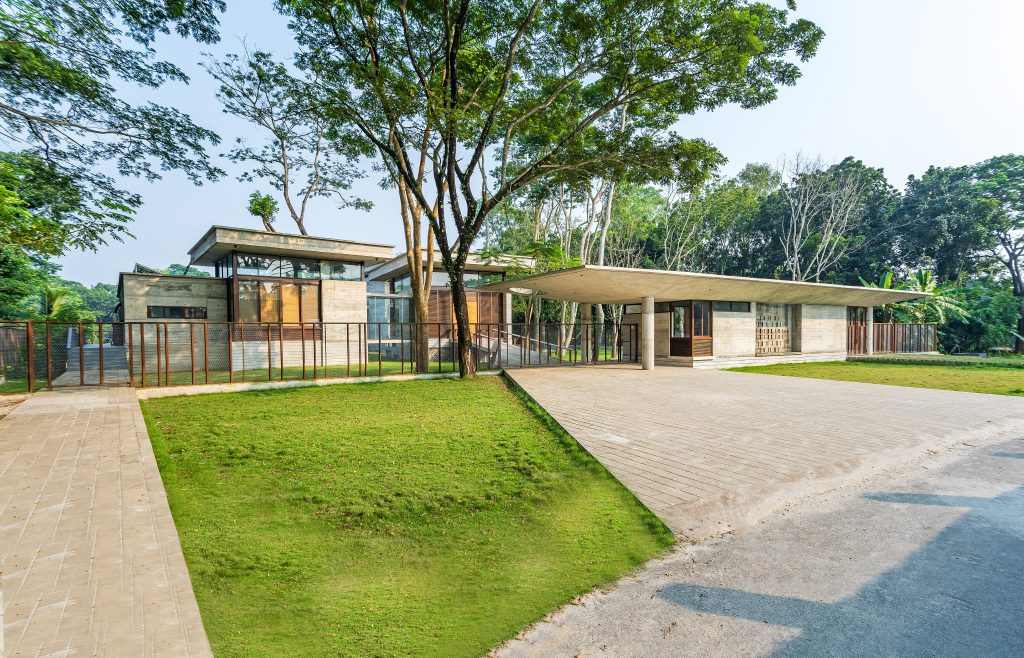
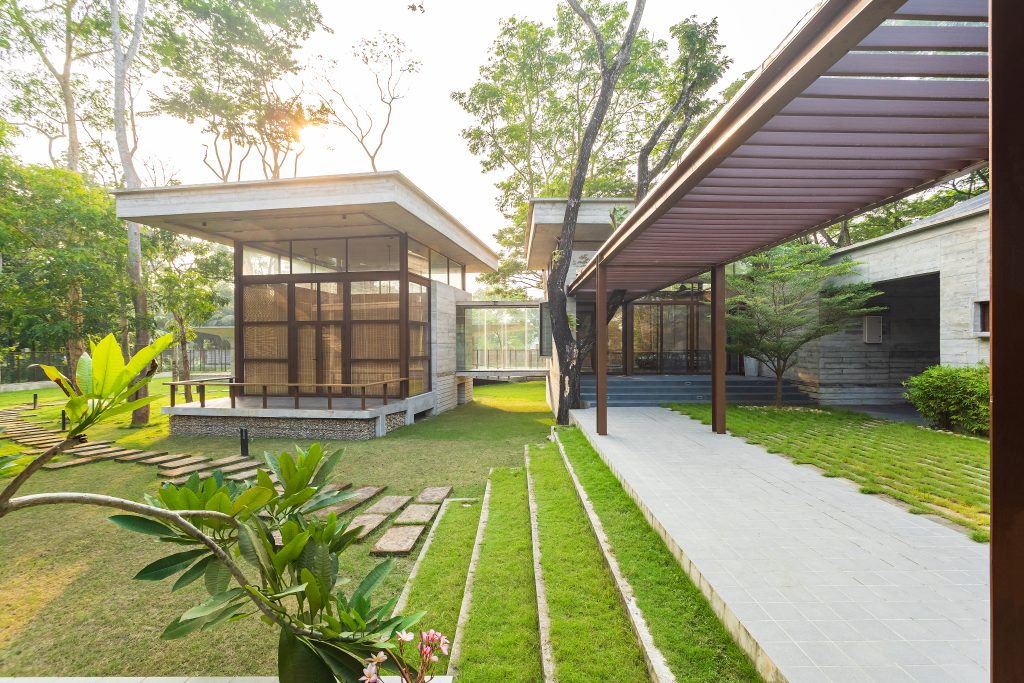
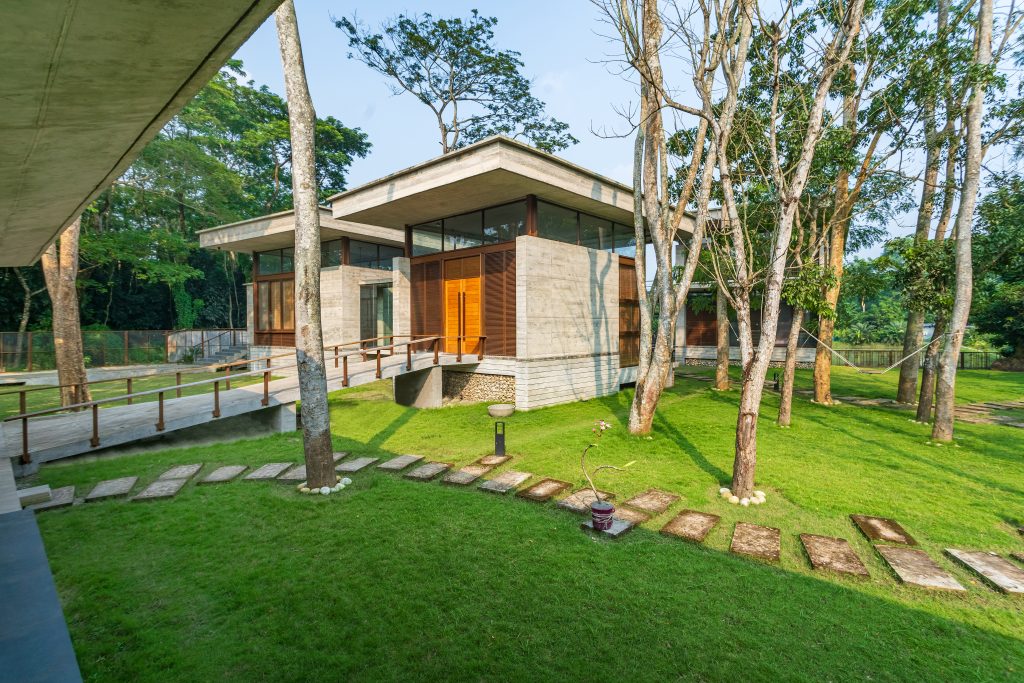
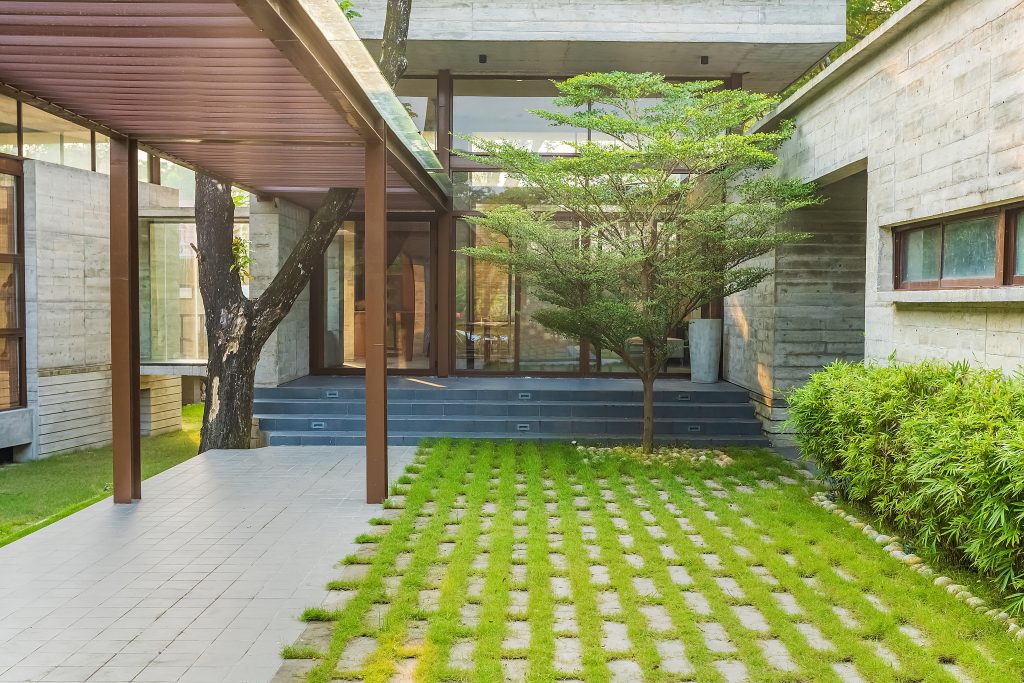
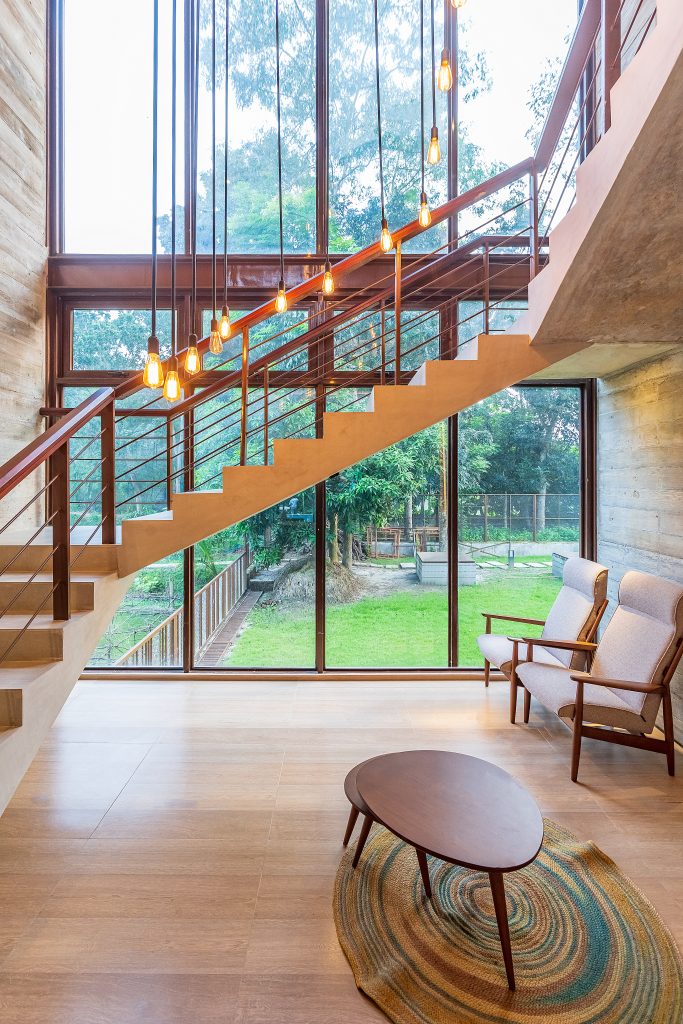
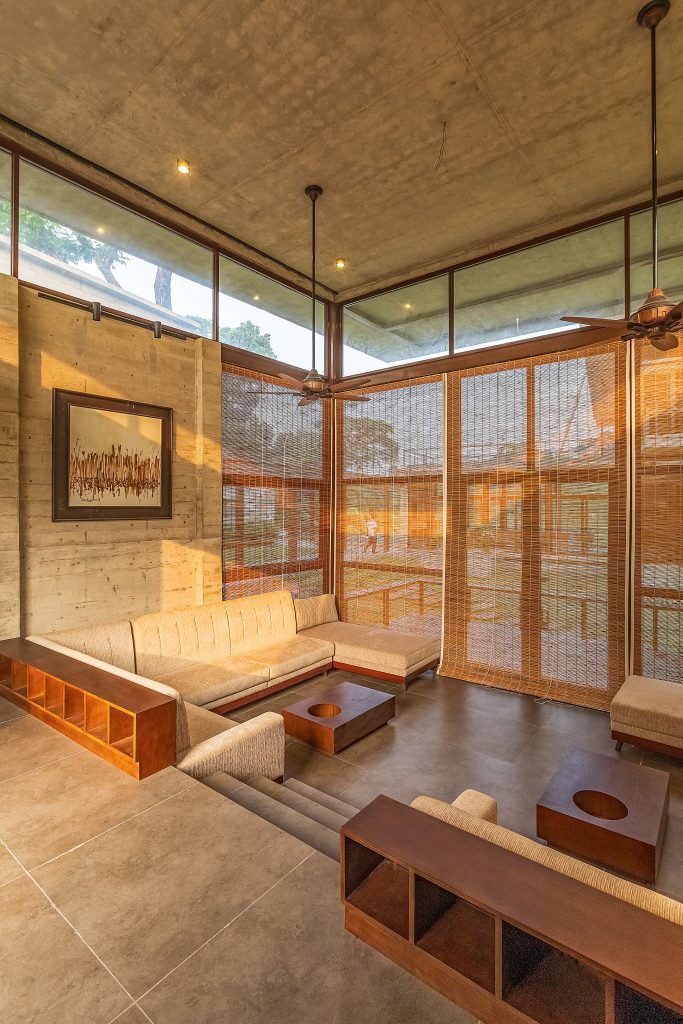
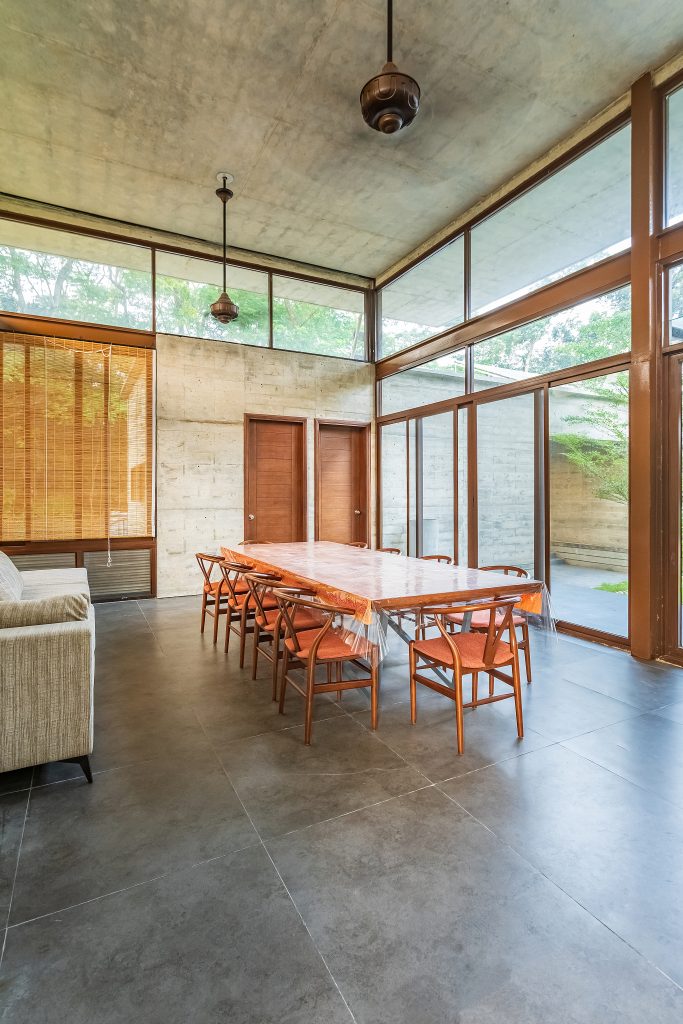
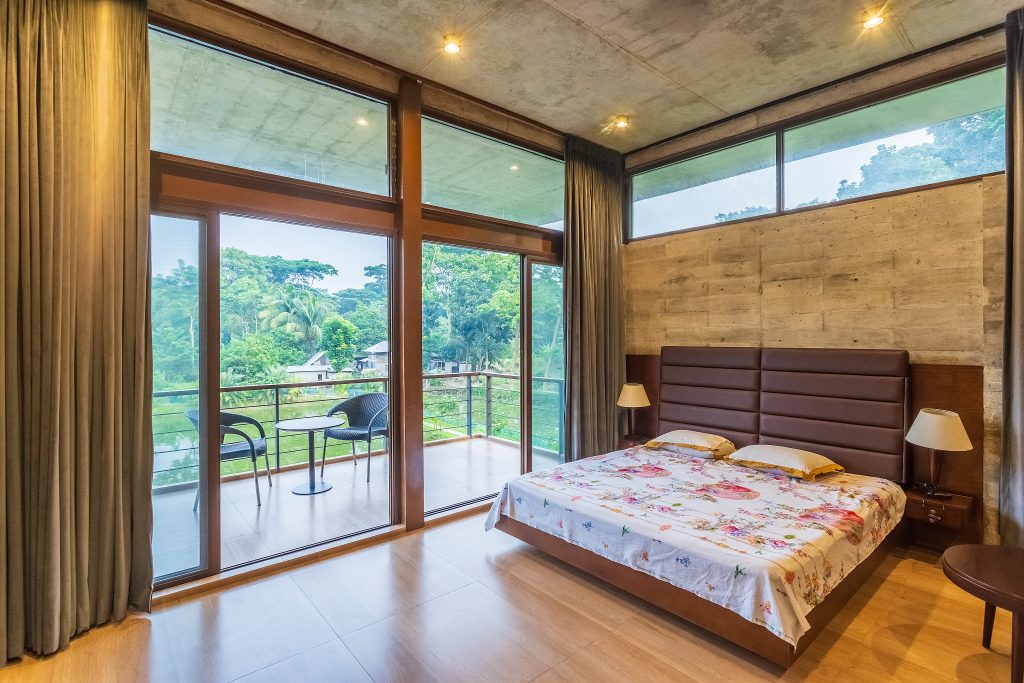
The site presented a unique canvas, characterized by irregular shapes, varying elevations, and diverse compositions, adorned with dense vegetation predominantly comprising small trees and greenery. The most captivating feature of the site is a large pond, which encompasses most of the three-acre property.
The project, initiated in 2020 and completed in 2022, was designed by a team of architects led by Principal Architect Mahtab Hussain Siddiqui and Project Architect Mehedi Amin, with contributions from architects Syed Anjan and Falguni Mozumdar, all under MW3 Design+Partners. According to their concept, “the design was conceptualized as a Corbusian promenade through Miesian pavilions contextualized for the subtropical climate. It takes cues from the surrounding architecture—raising the plinth to avoid flooding and extending eaves to protect from the rain and the sun.”
The architectural design is well thought out as a harmonious blend of Corbusier principles—a promenade reminiscent of Le Corbusier’s vision, interwoven with Miesian pavilions adapted to the demands of a sub-tropical climate.
The entrance to the house is artfully designed, featuring a welcoming frontcourt and a gatehouse. Visitors are then led on a gradual journey, ascending a wide ramp that allows them to immerse themselves gradually in the natural surroundings.
Upon entering the interior, a grand formal living space unveils itself, marked by an enchanting seventeen-foot-high opening leading to a spacious terrace. Here, a low wooden railing offered functionality as both safety and seating.
A narrow glass bridge connects the living area to the dining space, providing a seamless transition. The dining area offers a spectacular panorama of the internal courtyard, partly shaded with pergolas and embellished with greenery. The family living area is strategically positioned to open up to all-encompassing views of the infinity pool, which gracefully extends towards the tranquil pond. A large deck framed the pool, gently descending to the water’s edge.
The family living space, in a brilliant architectural twist, is partly positioned above the water, affording scenic views of the courtyard and the picturesque pond. This architectural complex is creatively connected to the bedrooms, with only a two-story structure within the ensemble. While two bedrooms face the garden, the other two elegantly hover above the tranquil waters, creating a symphony of design and nature that defines this remarkable dwelling.
An integral aspect of the project involves the deliberate detachment of the complex, designed to preserve the existing vegetation. This attempt was informed by a careful site survey, providing precise data on the location and dimensions of the trees, the majority of which were thoughtfully safeguarded during the design process. To minimize the impact on the natural landscape, the service block was positioned within a ditch, thereby avoiding the need to cut down any trees. Furthermore, a portion of the family living area and the bedrooms were strategically placed over the pond, offering both breathtaking views and an environmentally sensitive approach that enhanced the overall project.

The wood formwork for the concrete was precisely supervised, leaving a fascinating imprint of its grain on the surface. This textured, earthy finish effortlessly blends in with the natural surroundings enveloping the structure. The utilization of structural steel was imperative, serving the dual purpose of expanding corner spaces and imparting the roof with a captivating floating effect.
In the interest of practicality, selected portions of wood were sensibly substituted with Aluminum and Wood-Plastic Composite (WPC) materials. The finishes selected for the project were a carefully arranged interplay of the various grays of concrete and the warm browns of wood, culminating in a harmonious and cohesive aesthetic.
Within the serene embrace of Naria village, this architectural expression not only provides a tranquil haven for the client’s family and guests but also honors a profound generational connection to their ancestral roots. With careful attention to detail in materials and design, the house gracefully integrates with the natural environment, offering an escape from the intensity of urban life in Dhaka.
6. In Quest Of Building Humane Architecture.
Architect Sayedul Hasan Rana is one of the most influential architects of Bangladesh. He completed his bachelor’s degree in architecture in the year 1989 from Bangladesh University of Engineering and Technology (BUET) is the principal architect of Architects Design Studio. In the long architecture journey, the designer has worked in several private practices on a broad range of regeneration projects in and around Singapore and Bangladesh. Commercial building Casablanca, the residential building Kusum Residence, Purbachal Library, and Zinda Park Complex, are some of the projects in the long list of his wonderful works. The architect greatly emphasizes in environmental susceptibility, low cost, and civic urban design. The architect opens up about his experiences and shares his architectural journey which has evolved over the years.
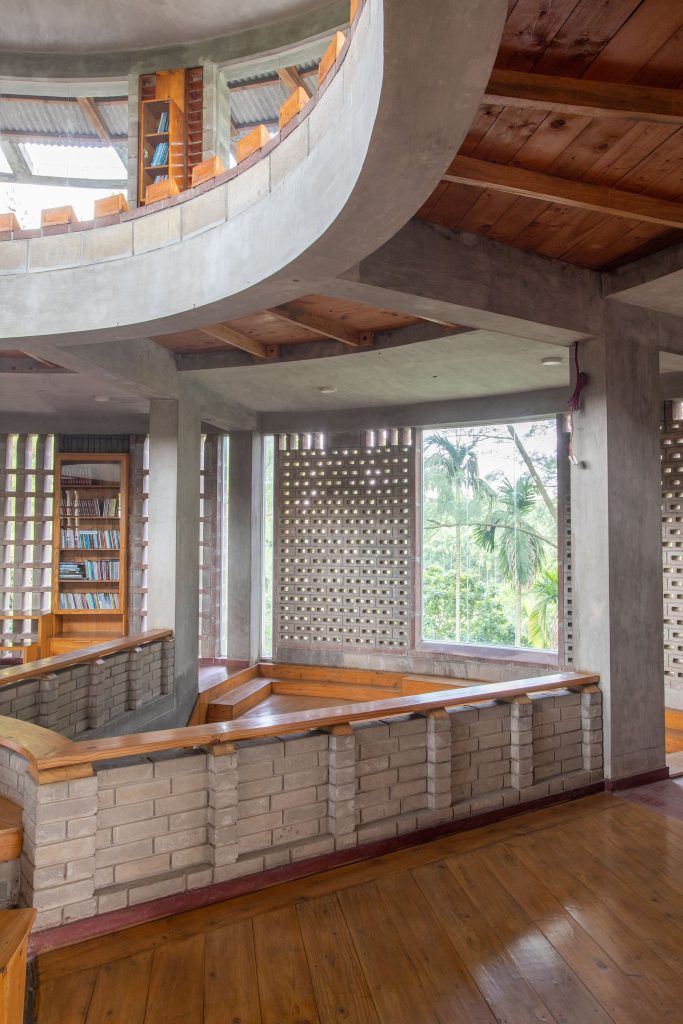
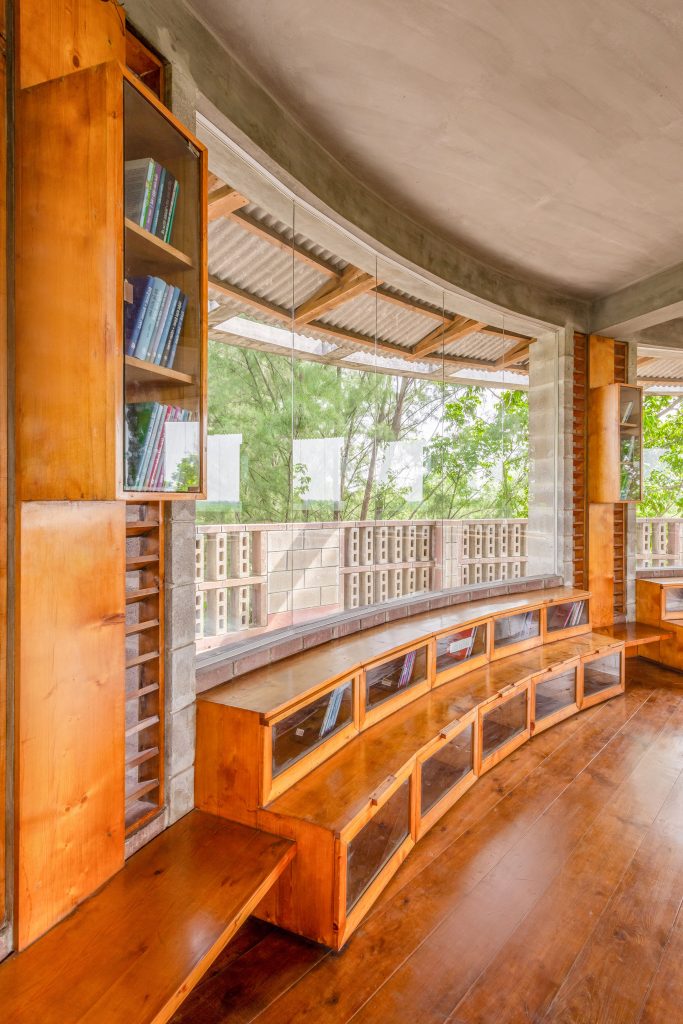
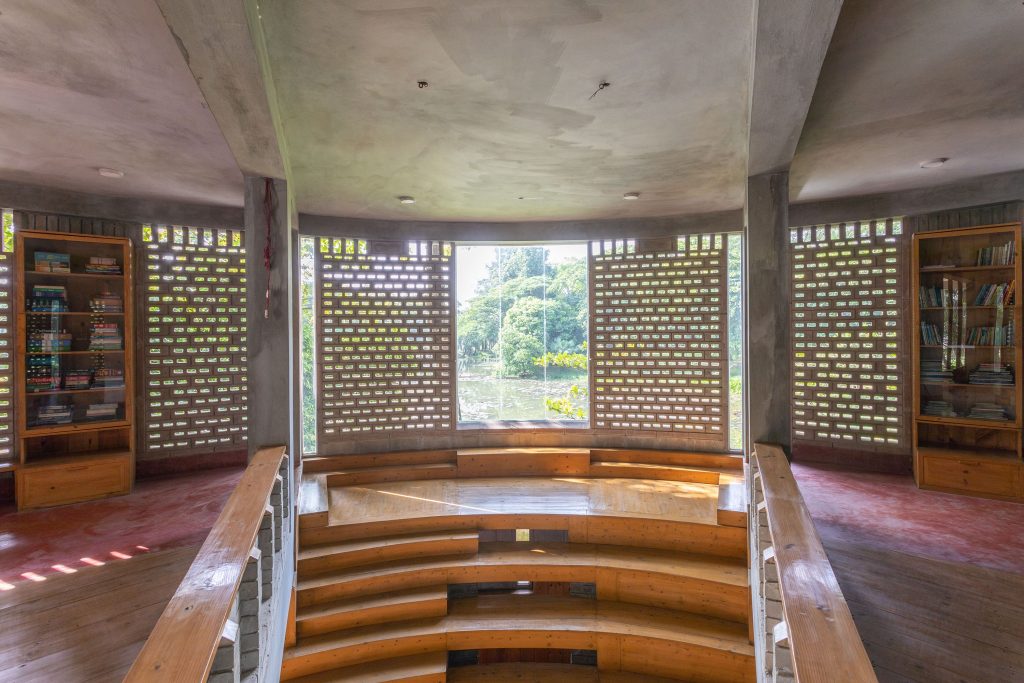
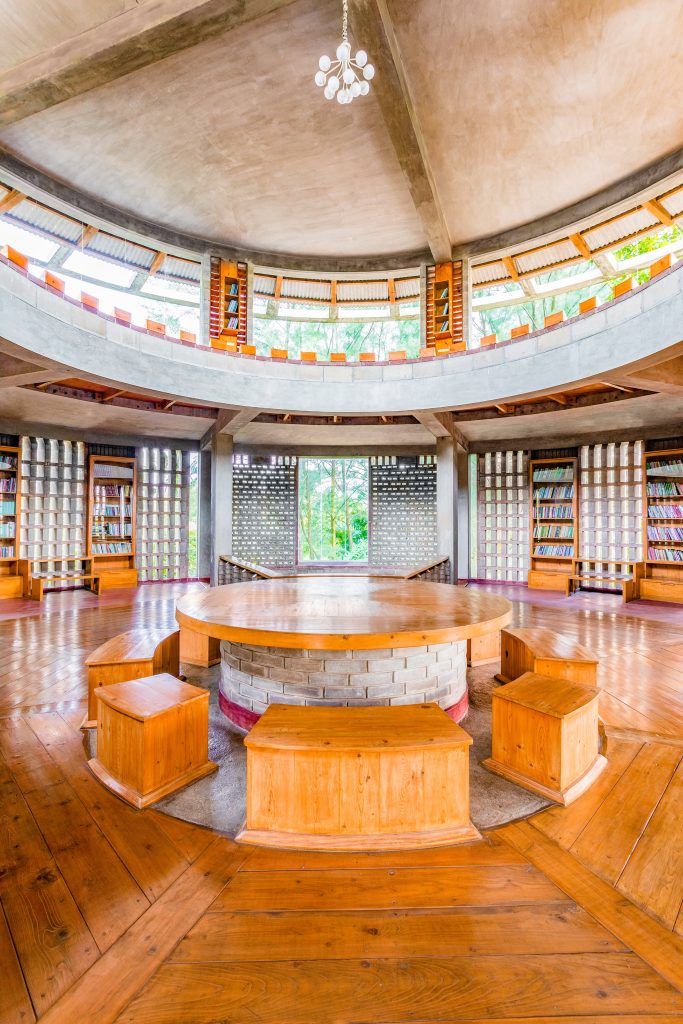
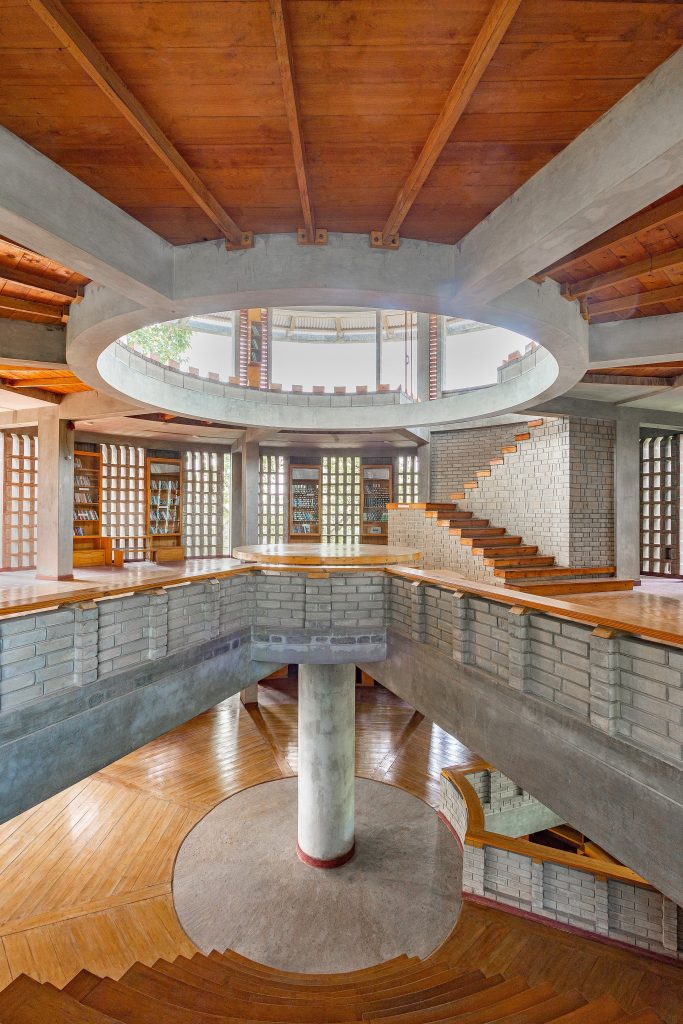
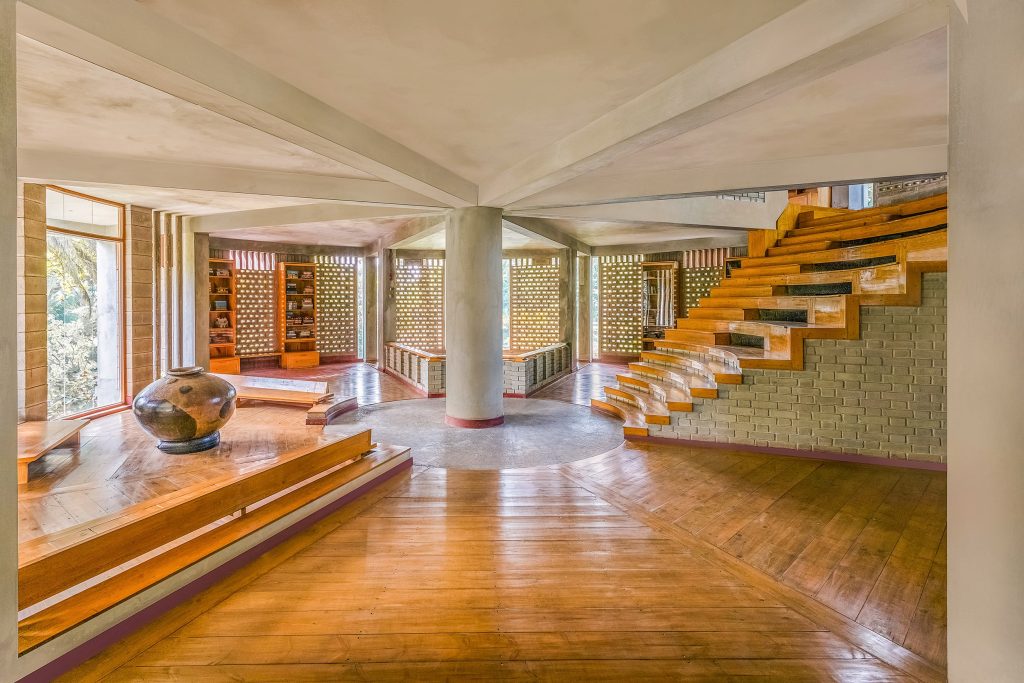
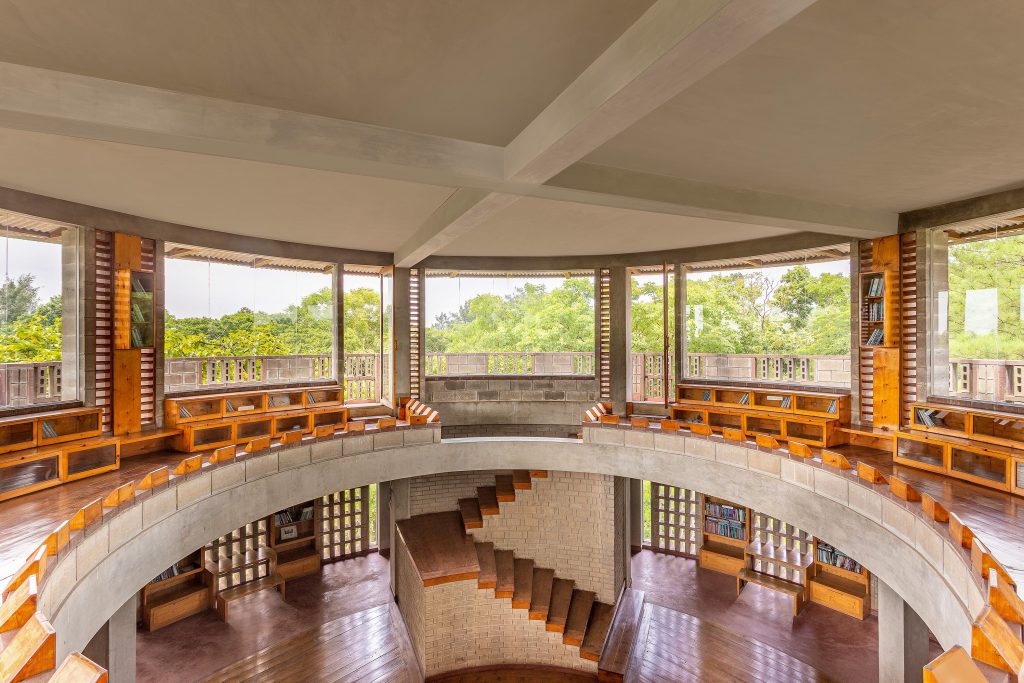
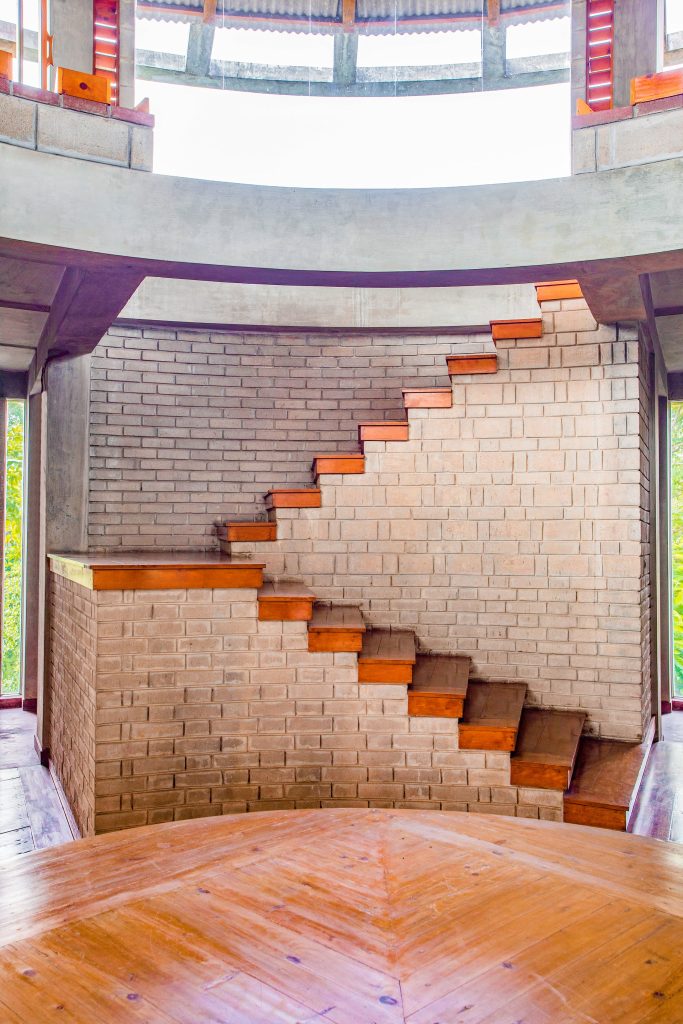
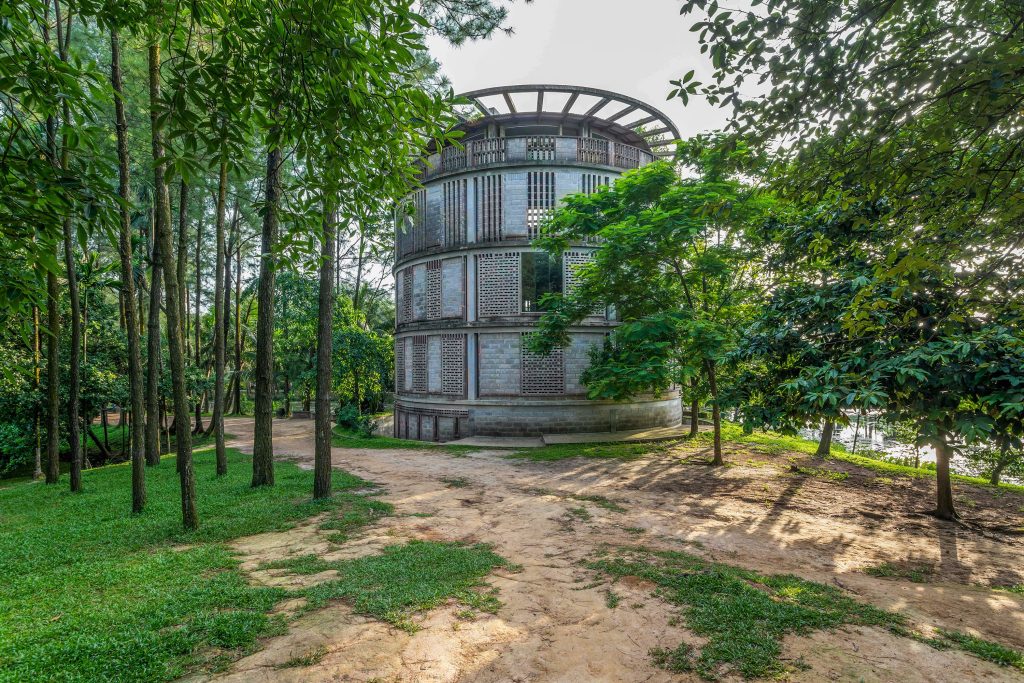
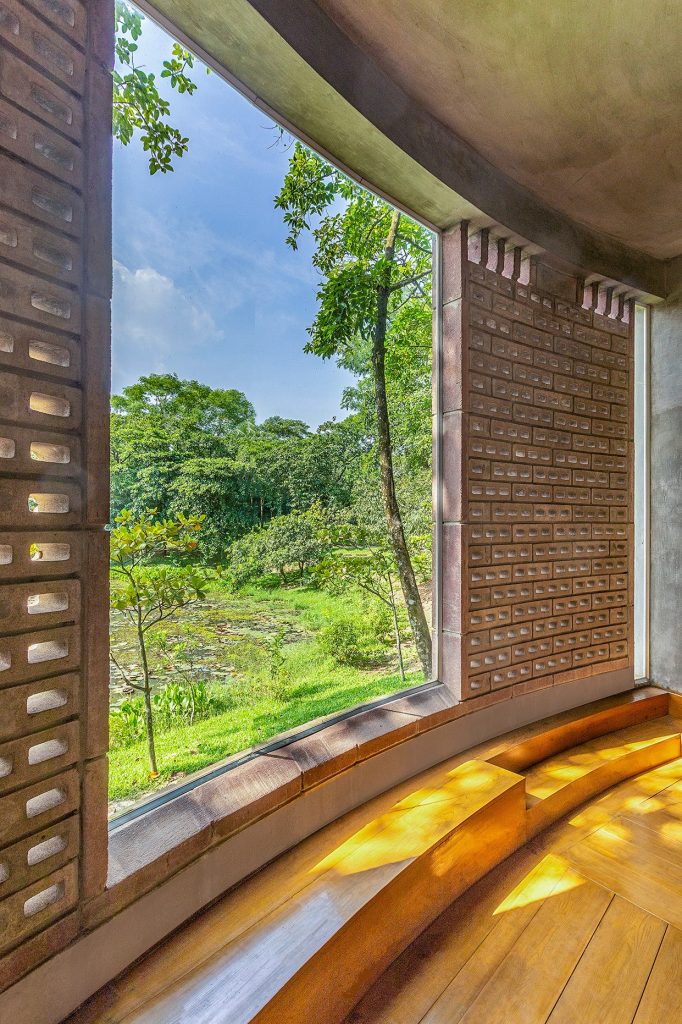
Nestled amidst the bustling urban landscape of Narayanganj, Bangladesh, lies a beacon of hope and sustainability – Zinda Park. Founded by Tobarok Hossain Kusom and his four friends with a vision to transform their village into an ideal community, Zinda Park stands as a testament to the power of collective action and environmental stewardship.
The journey of Zinda Park began with a simple yet ambitious proposition – to create a well-established haven for villagers amidst the rapid urbanization sweeping across Bangladesh. Surrounded by three lakes and adorned with over 20,000 trees of various species, the park emerged as a sanctuary for both humans and wildlife alike.
At the heart of Zinda Park’s development lies the visionary architect Sayedul Hasan Rana, whose designs seamlessly blend modernity with environmental sustainability. From the contemporary structures of the Casablanca commercial building to the eco-friendly brick façade of the Little Angels’ School, Rana’s architectural prowess has left an indelible mark on the landscape of Zinda Park.
Central to Zinda Park’s ethos is community engagement and participation. Meetings under the shade of trees or at the local tea stalls serve as platforms for dialogue and collaboration, where villagers, technicians, vendors, and even the park’s resident animals engage in discussions about the park’s development. This inclusive approach not only fosters a sense of ownership among the locals but also ensures that their voices are heard in shaping the park’s future.
Over the years, Zinda Park has evolved into a self-sustaining ecosystem of education, healthcare, and recreation. From the humble beginnings of a tin shade structure housing the Little Angels’ School to the sprawling complex of educational institutions, community clinics, and libraries, Zinda Park has become a beacon of hope for rural communities striving for self-sufficiency.
The story of Zinda Park is not just about infrastructure development; it is about empowerment and resilience in the face of urbanization. By generating its income and creating employment opportunities for villagers, Zinda Park has become a model for sustainable development, proving that thriving communities can flourish even amid rapid urbanization.
At the core of Zinda Park’s success is its commitment to environmental sustainability. With innovative designs that prioritize natural ventilation and ample sunlight, buildings like the Little Angels’ School and the Zinda Park Library epitomize eco-friendly architecture. These structures not only reduce energy consumption but also create a conducive learning environment for students.
Beyond its physical infrastructure, Zinda Park serves as a bridge between rural traditions and urban aspirations. As cities expand and villages disappear at an alarming rate, Zinda Park stands as a testament to what is possible when communities come together to create a better future for themselves.
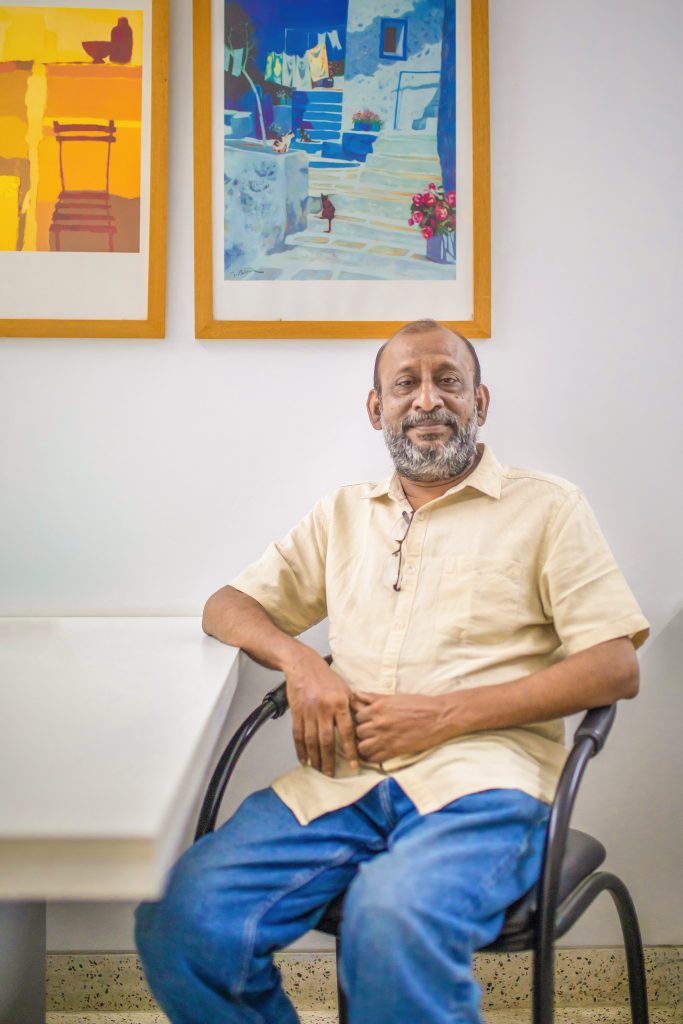
Zinda Park offers a glimmer of hope. Its model of eco-friendly community development inspires us to rethink our approach to urbanization and prioritize the well-being of both people and the planet. As we strive to build a more sustainable future, let us look to Zinda Park as a guiding light, reminding us that with determination and collaboration, we can create thriving communities that coexist harmoniously with nature.
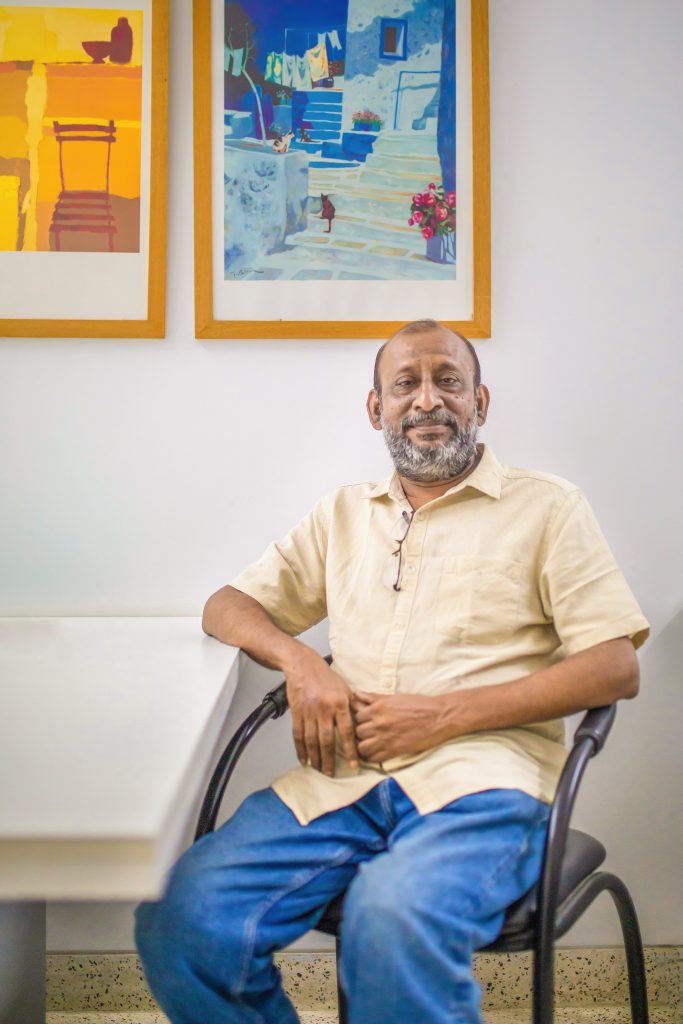
In a world grappling with the consequences of unchecked urbanization and environmental degradation, Zinda Park stands as a shining example of what is possible when communities prioritize sustainability and collective action. Its story reminds us that the path to a brighter future begins with a commitment to nurturing our natural surroundings and empowering local communities. As we strive to build a more sustainable world for future generations, let us draw inspiration from the remarkable journey of Zinda Park and work together to create thriving, eco-friendly communities that embody the principles of harmony, resilience, and stewardship.
7. Dwelling in Coherence and Cohesion – Khan House, Bashundhara
Taking cues from the client’s desire for an abode of togetherness, relaxation, and appreciation of gardens and terraces, the spaces within this single-family residence are planned with integrated natural surroundings that run deep inside the house. The spaces flow between one another, exuding a sense of openness while retaining their functionality. The residential project, ‘Khan House’ designed by Ground One, commenced in the year 2017, and after the challenges and delays caused by the epidemic, it reached its completion in 2022.
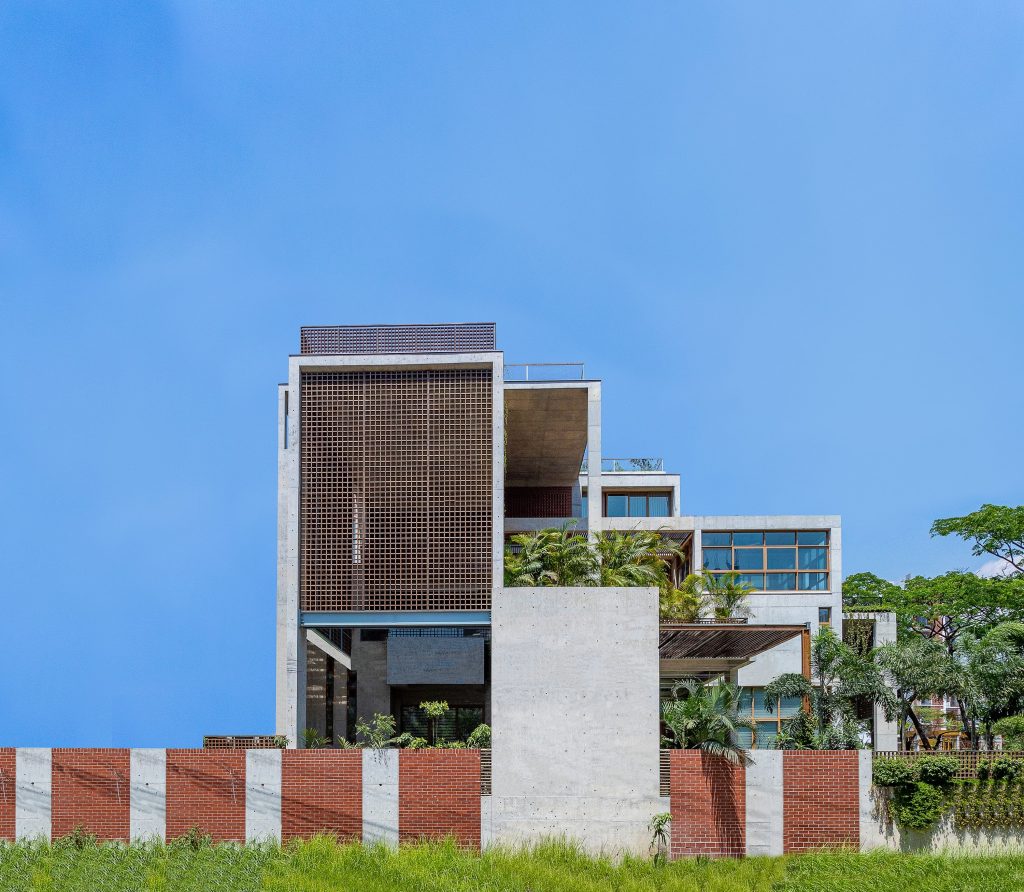
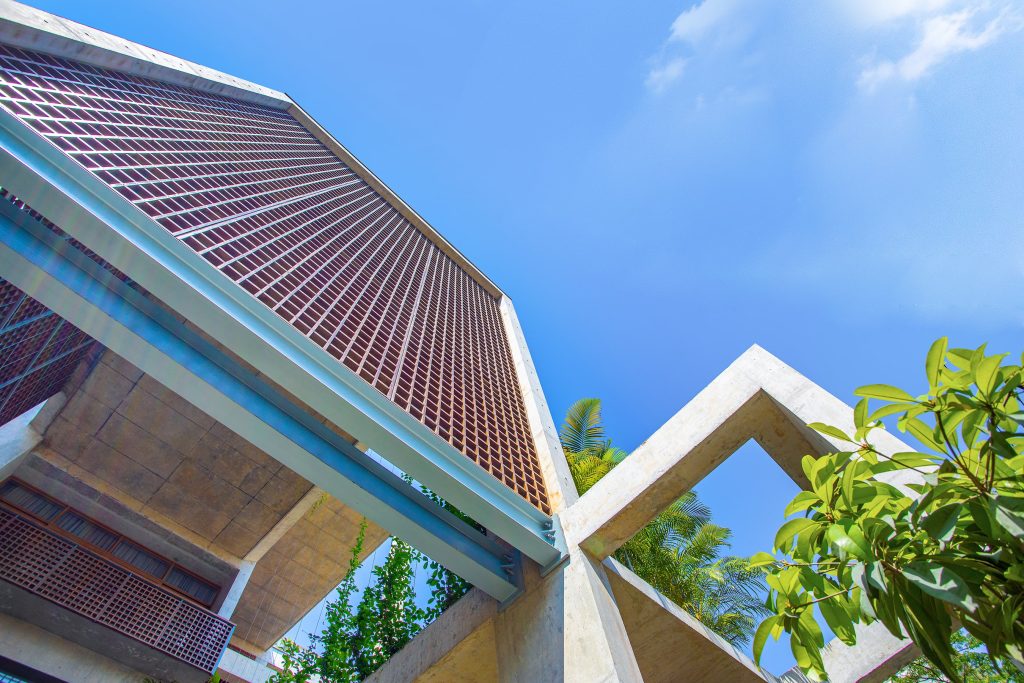
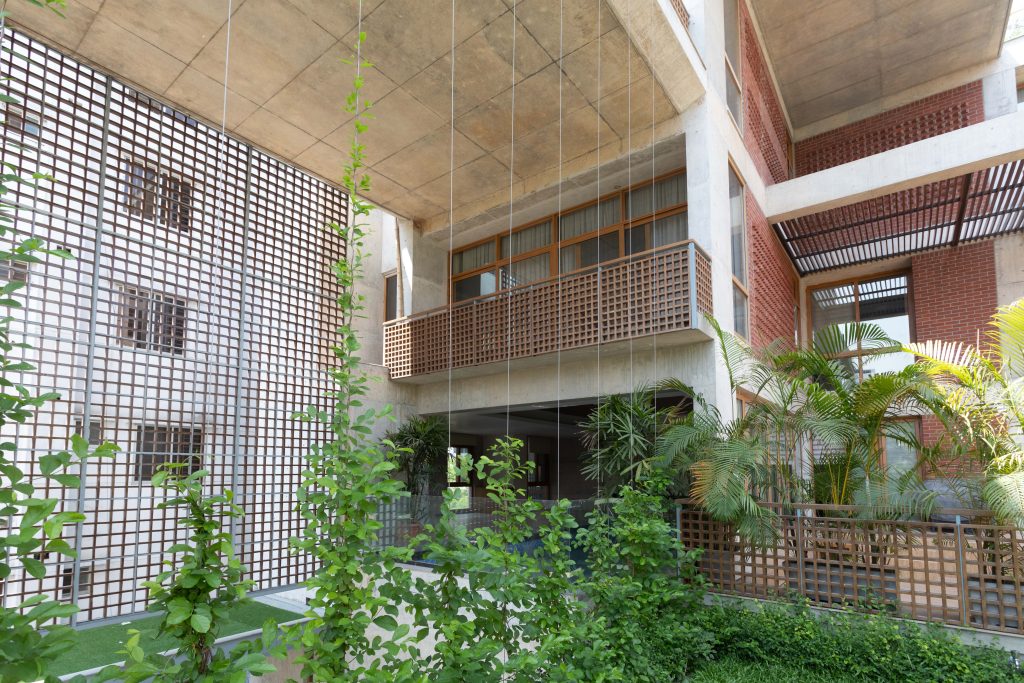
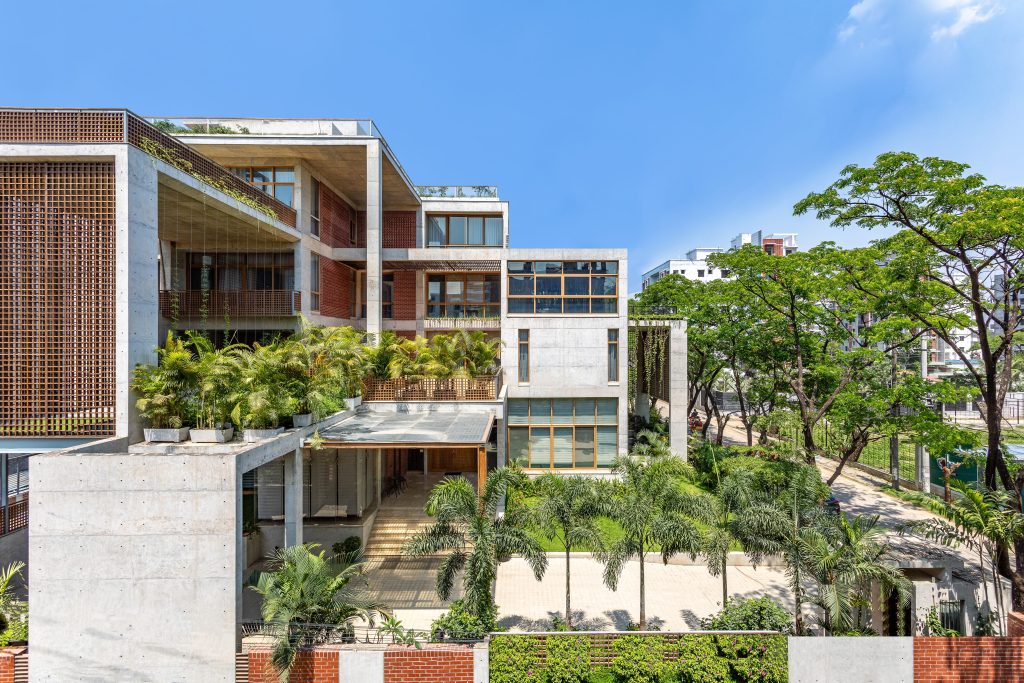
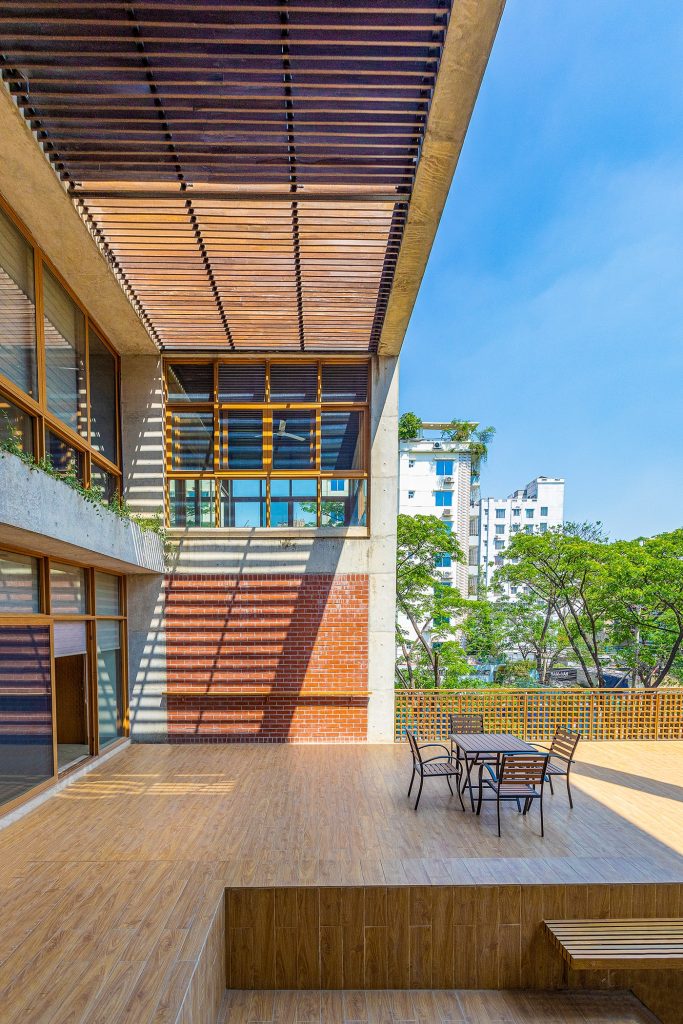
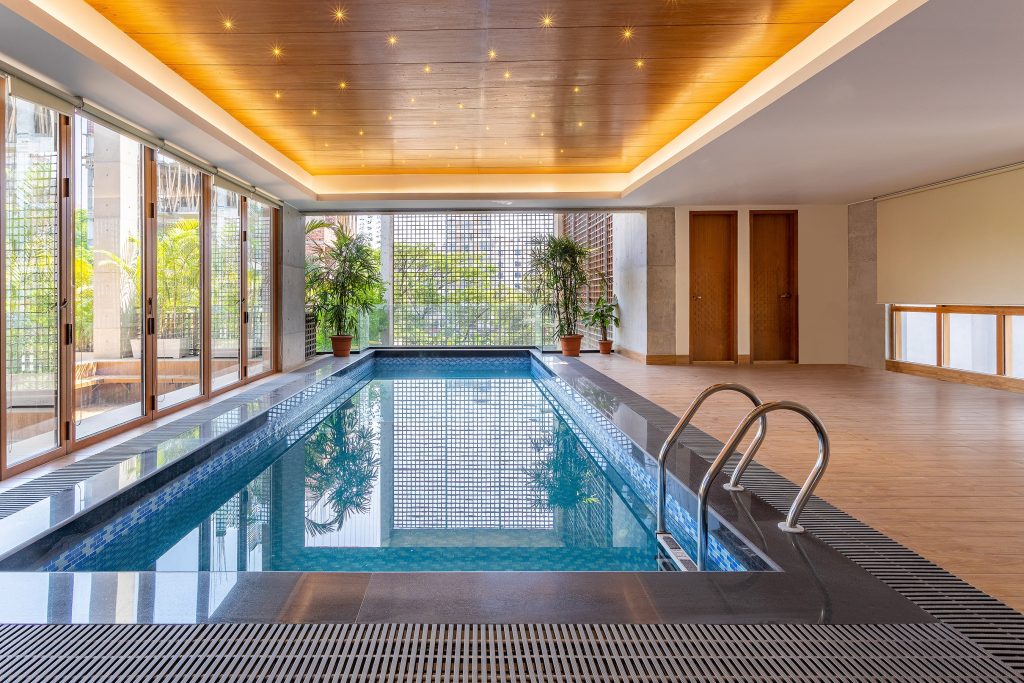
Local materials such as brick and concrete are predominantly used in the building. Nature has influenced the materiality of the residence. The trees, the sunlight, and the air all contribute to creating an effortless experience of positivity, with a flawless scenario of architectural and volumetric composition. Transcending conventional norms, the bedrooms have been designed spaciously, with a terrace. The interior spaces are also thoughtfully designed, where the open terraces are incorporated with functions. The project was led by Md. Shahnawaz, Principal Architect of Ground One, along with the architect team: Al Numan Md. Younus, Dhruba J. Das, Ahmed Rajeeb, Emtiaz Zafree, Asif M Noeem.
The biophilic concept of living with vegetation played an essential role in the material palette, blurring the lines between indoor and outdoor relationship.
“Ensuring privacy was a concern for the family,” shares Architect Md. Shahnawaz. “We employed screens on the exterior façade, maintaining tonal balance and securing the privacy of the users.” The wooden screens enhance the texture of the exterior design of the building while ensuring privacy as well as allowing natural light and ventilation. Families in Bangladeshi communities come together and enjoy “tea-time” which is one of their favorite pleasures. Common spaces for these amicable conversations, or “tea-time,” were another requirement of the client. The tradition is so deeply embedded in Bengali culture that many residents are oblivious to it as a potential cultural treasure that will one day be lost within their families. Spaces within the home were created that could offer these experiences and rekindle the family’s sense of harmony and unity. Based on this concept, the architect placed the grandmother’s bedroom on the first floor adjacent to an open terrace overlooking the pool and gardens, which rendered it the family’s favorite spot for interactions.
The architect strove towards simplicity of articulation and richness of spirit and endeavored for a space that embodied human emotions and sentiments rather than being an enclosure erected with building materials.
The paradigm of togetherness and belonging was therefore set by the Khan House. Describing his process of work, Architect Shahnawaz discussed that he considers the demands of his client with the utmost importance, “My work begins with an idea, and then I integrate spaces that accommodate those ideas while staying in line with the needs of the client.”
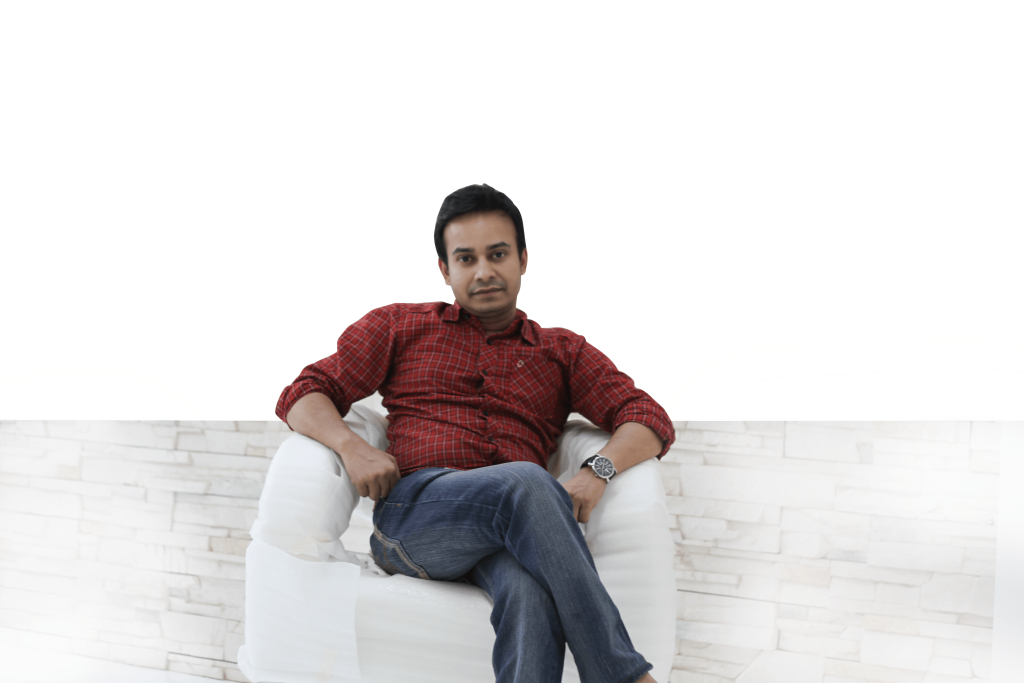
The architect believes that in the current scenario in Bangladesh, we are entering a magnificent time marked by the influence of modernity in our architectural expression. He is inspired by those architectural examples in our country where traditional context is respected along with climatic and environmental concerns. He continues, “We should utilize our natural resources as assets and allow ourselves to be molded by our contextual tradition.”
Over the years, the works of master architects have had an impressive impact on Architect Shahnawaz. Especially, the architectural style of Louis I Khan has always inspired him. He also admires the creations of architects Alvar Aalto, Frank Lloyd Wright, and Le Corbusier. Architect Shahnawaz views architecture as a language. He shares, “Architecture, to me, is a language of art that is expressed in buildings – where the function is integrated with the art itself.” Architecture is a different kind of art that is combined with functionality. I would advise the young architects to understand and analyze the functions before, and eventually go for an aesthetic approach.” He adds, “A functional design, is going to take time. The philosophy of combining architecture and art is very important.”
8. Soothing Serenity.
Amidst the chaos of city life, lies a hidden gem that offers solace and serenity to weary souls. Gala Makeover Studio and Salon-Gala Wellness Centre Level 3, owned by Navin Ahmed, is not just another spa—it’s a tranquil oasis designed to envelop guests in a cocoon of calmness and peace.
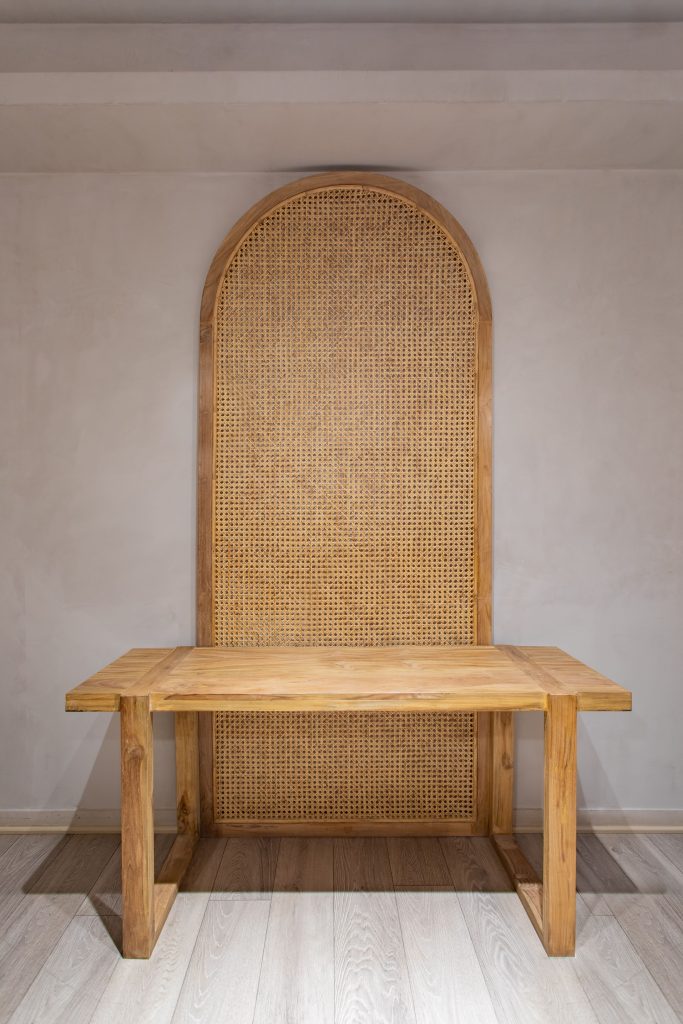
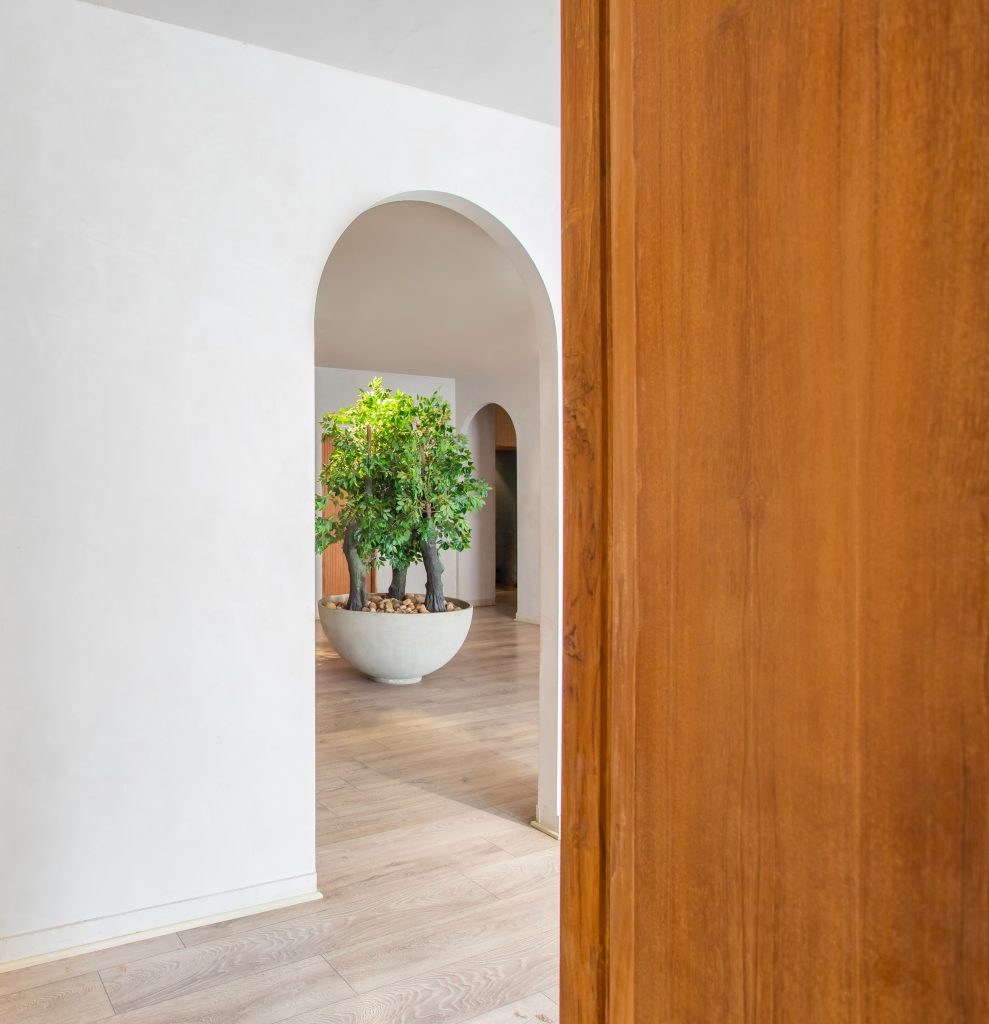
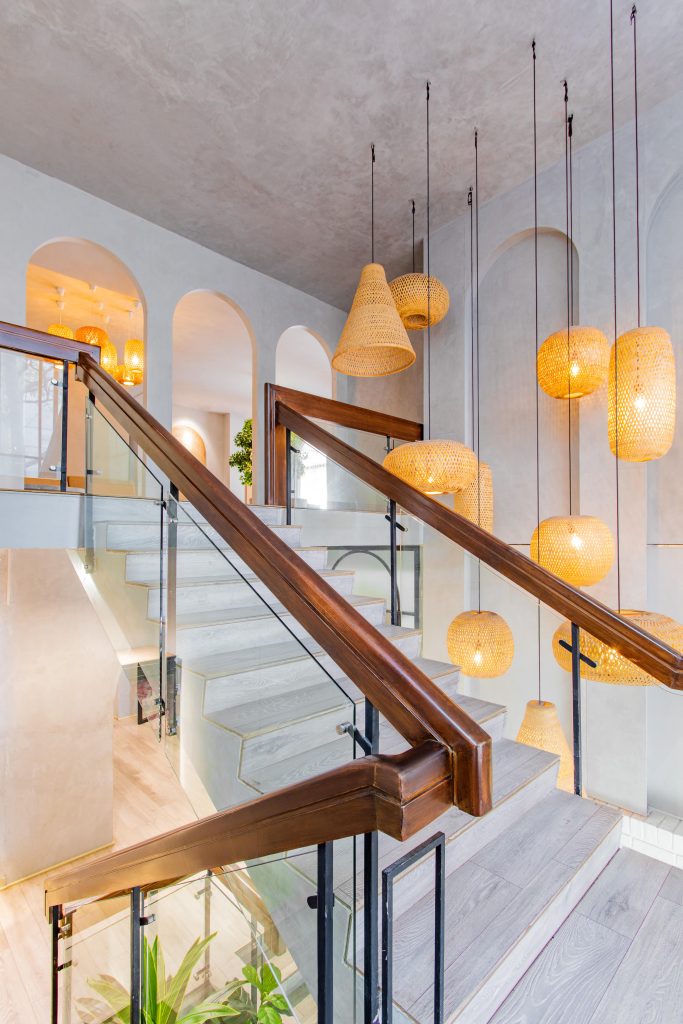
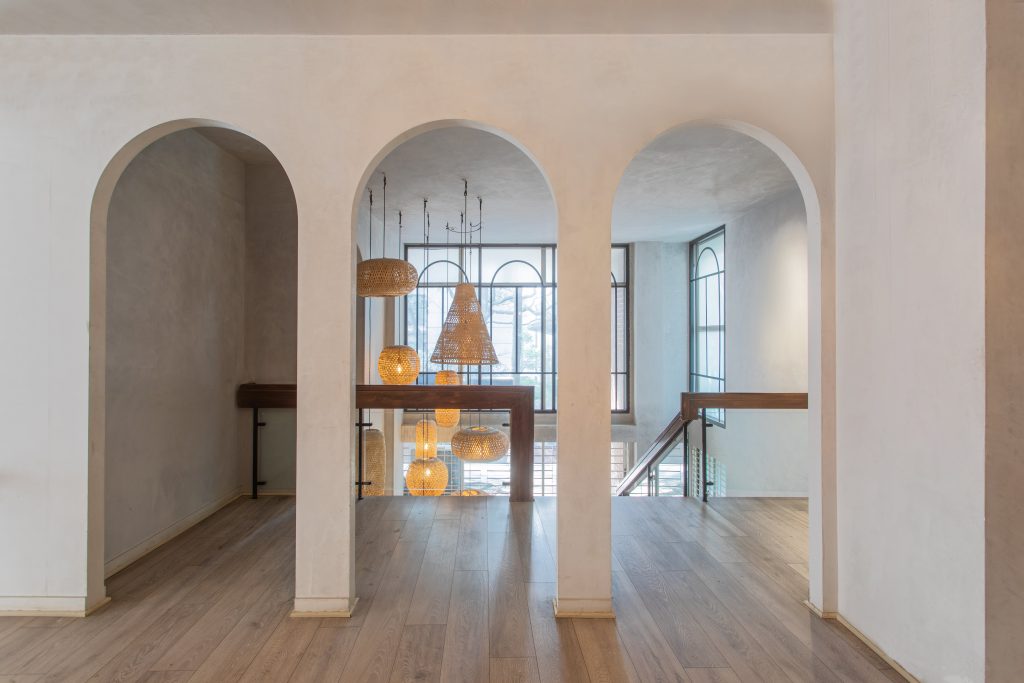
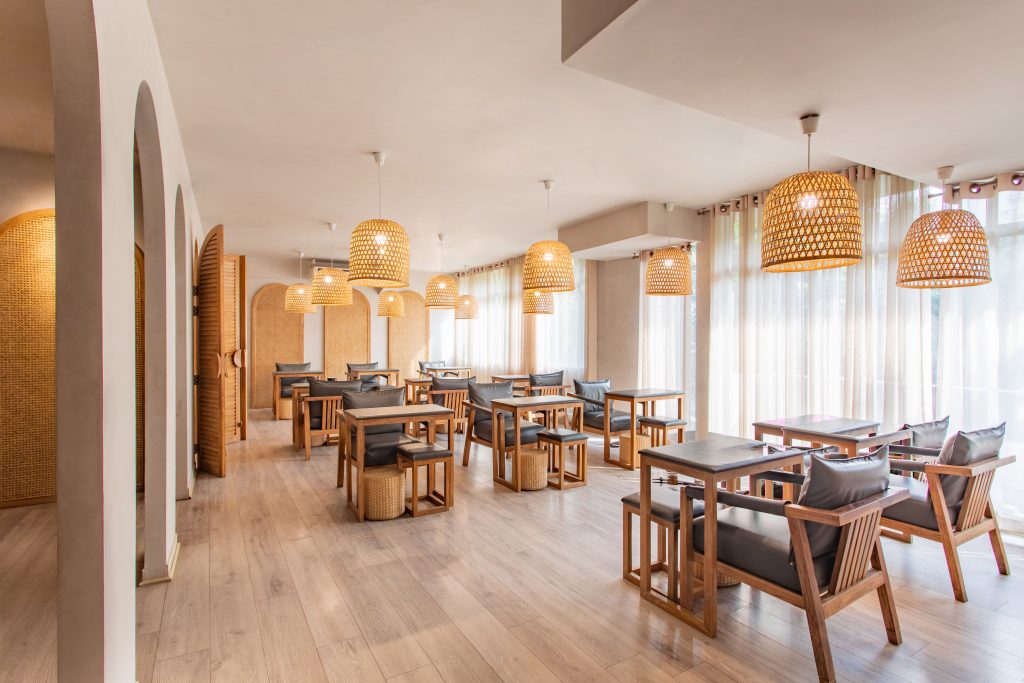
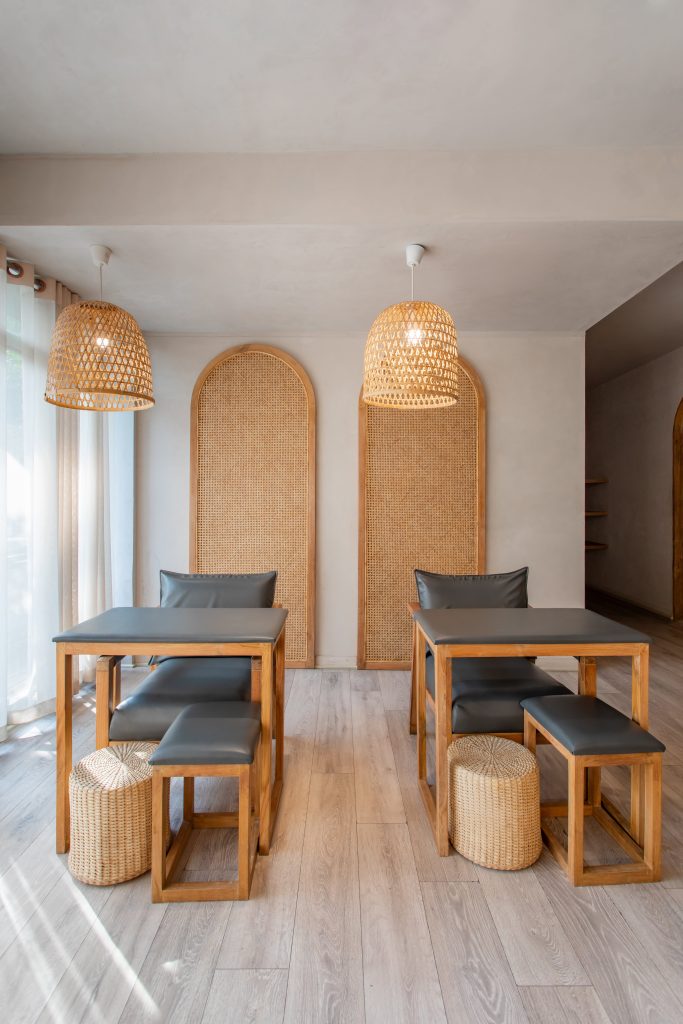
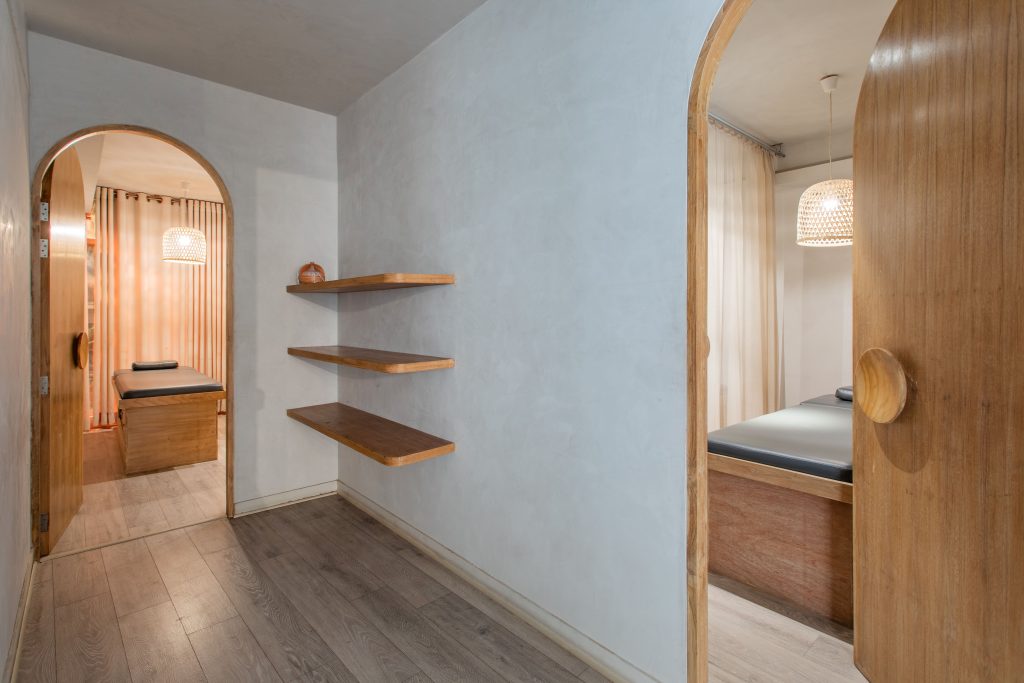
Architect Rafia Mariam Ahmed, principal Architect, RMA Architects envisioned Gala Makeover Studio and Salon-Gala Wellness Centre level 3 as a reflection of peace and calmness, in favor of a more authentic aesthetic. The result is a space that feels distinctly Dhaka—a place where guests can escape the hustle and bustle of urban life and find respite for both body and mind.
Spread across 2200 square feet, every inch of Gala Makeover Studio and Salon is imbued with the essence of local materials and design elements. From the moment guests step through the door, they are enveloped in a sense of tranquility, thanks to the soft, dimmed lighting that bathes the space in a warm and inviting glow.
One of the defining features of Gala Makeover Studio and Salon is its use of natural light. Strategically managed sunlight filters through the windows, creating an ambiance that is both soothing and rejuvenating. Combined with the soft, dimmed lighting, it helps to create an atmosphere of relaxation and calmness—a welcome escape from the chaos of the outside world.
As guests explore the spa, they will discover a harmonious blend of rustic charm and sleek sophistication. Wooden furniture and rattan lanterns add a touch of warmth and texture to the space, while graceful arches lend an air of elegance and grace. Each zone within the spa is carefully curated to offer a unique experience, from the welcoming sitting area adorned with an impressive big tree to the open pedicure and manicure stations decorated with wooden and rattan accents. The staircase, adorned with mesmerizing lanterns, offers a captivating view that draws guests deeper into the tranquil oasis of Gala Makeover Studio and Salon-Gala Wellness Centre.
Amidst the hustle and bustle of city life, guests can take a moment to pause, breathe, and reconnect with themselves.
One of the most striking features of Gala Makeover Studio and Salon-Gala Wellness Centre is its commitment to locally sourced craftsmanship and design. From the handcrafted tea table to the raw rattan accents, every detail reflects a dedication to supporting local artisans and celebrating the rich cultural heritage of Dhaka city.
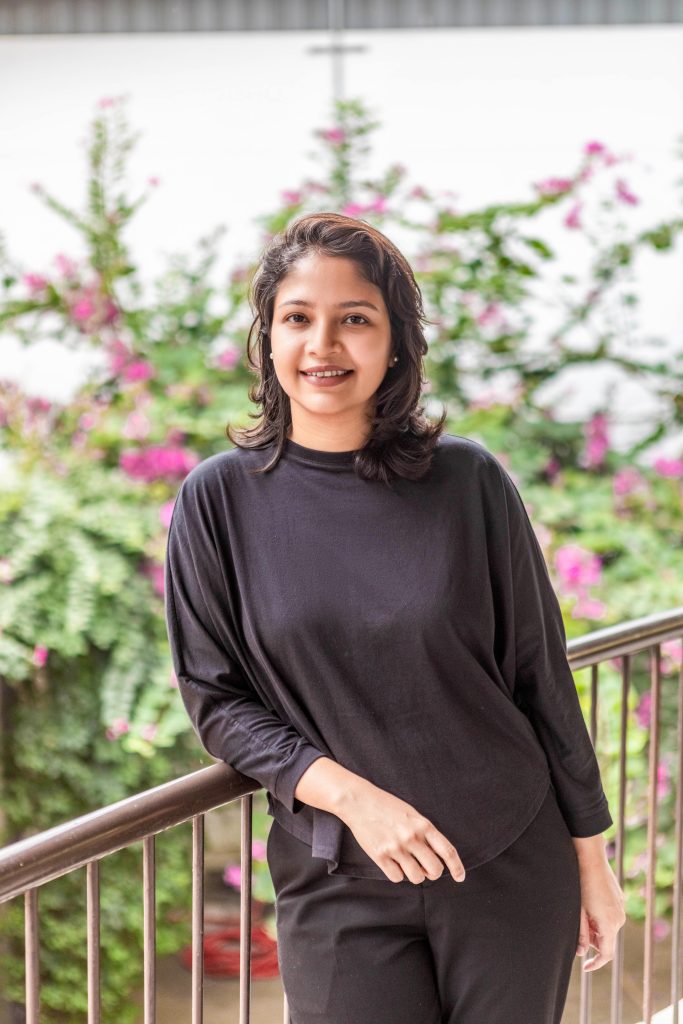
The color palette of gray and light brown further enhances the sense of calmness and tranquility, creating a cohesive and soothing environment that envelops guests in a feeling of peace and relaxation. With no pop of vibrant colors to disrupt the serenity, Gala Makeover Studio and Salon is a place where guests can truly unwind and escape the stresses of daily life.
Gala Makeover Studio and Salon is more than just a spa—it’s a sanctuary for the body, mind, and soul. Here, amidst the chaos of city life, guests can find refuge and rejuvenation, allowing them to emerge feeling refreshed, revitalized, and ready to face the world once more.

